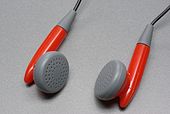

Headphones are a pair of small loudspeaker drivers worn on or around the head over a user’s ears. They are electroacoustic transducers, which convert an electrical signal to a corresponding sound. Headphones let a single user listen to an audio source privately, in contrast to a loudspeaker, which emits sound into the open air for anyone nearby to hear. Headphones are also known as earspeakers, earphones[1] or, colloquially, cans.[2] Circumaural (‘around the ear’) and supra-aural (‘over the ear’) headphones use a band over the top of the head to hold the speakers in place. Another type, known as earbuds or earpieces[1] consist of individual units that plug into the user’s ear canal. A third type are bone conduction headphones, which typically wrap around the back of the head and rest in front of the ear canal, leaving the ear canal open. In the context of telecommunication, a headset is a combination of headphone and microphone.
Headphones connect to a signal source such as an audio amplifier, radio, CD player, portable media player, mobile phone, video game console, or electronic musical instrument, either directly using a cord, or using wireless technology such as Bluetooth, DECT or FM radio. The first headphones were developed in the late 19th century for use by telephone operators, to keep their hands free. Initially the audio quality was mediocre and a step forward was the invention of high fidelity headphones.[3][4]
Headphones exhibit a range of different audio reproduction quality capabilities. Headsets designed for telephone use typically cannot reproduce sound with the high fidelity of expensive units designed for music listening by audiophiles. Headphones that use cables typically have either a 1/4 inch (6.35mm) or 1/8 inch (3.5mm) phone jack for plugging the headphones into the audio source. Some stereo earbuds are wireless, using Bluetooth connectivity to transmit the audio signal by radio waves from source devices like cellphones and digital players.[5] As a result of the Walkman effect, beginning in the 1980s, headphones started to be used in public places such as sidewalks, grocery stores, and public transit.[6] Headphones are also used by people in various professional contexts, such as audio engineers mixing sound for live concerts or sound recordings and DJs, who use headphones to cue up the next song without the audience hearing, aircraft pilots and call center employees. The latter two types of employees use headphones with an integrated microphone.
History
Headphones grew out of the need to free up a person’s hands when operating a telephone. There were several iterative products that were predecessors to the «hands-free» headphones. By the 1890s the first device that is unmistakably a headphone was made by a British company called Electrophone, which created a system allowing their customers to connect into live feeds of performances at theaters and opera houses across London. Subscribers to the service could listen to the performance through a pair of massive earphones that connected below the chin, held by a long rod.[7]
French engineer Ernest Mercadier patented a set of in-ear headphones in 1891, Mercadier was awarded U.S. Patent No. 454,138 for “improvements in telephone-receivers…which shall be light enough to be carried while in use on the head of the operator.[7]”
Nathaniel Baldwin of Utah in 1910 invented a prototype telephone headset due to his inability to hear sermons during Sunday service. He offered it for testing to the US Navy, which promptly ordered 100 from Baldwin. Wireless Specialty Apparatus Co., in partnership with Baldwin Radio Company, set up a manufacturing facility in Utah to fulfill orders. His innovations were the basis of “sound-powered” telephones or phones that required no electricity, which were used during World War II.[8]

Brandes radio headphones, circa 1920
Headphones originated from the telephone receiver earpiece, and were the only way to listen to electrical audio signals before amplifiers were developed.
These early headphones used moving iron drivers,[9] with either single-ended or balanced armatures. The common single-ended type used voice coils wound around the poles of a permanent magnet, which were positioned close to a flexible steel diaphragm. The audio current through the coils varied the magnetic field of the magnet, exerting a varying force on the diaphragm, causing it to vibrate, creating sound waves. The requirement for high sensitivity meant that no damping was used, so the frequency response of the diaphragm had large peaks due to resonance, resulting in poor sound quality. These early models lacked padding, and were often uncomfortable to wear for long periods. Their impedance varied; headphones used in telegraph and telephone work had an impedance of 75 ohms. Those used with early wireless radio had more turns of finer wire to increase sensitivity. Impedance of 1,000 to 2,000 ohms was common, which suited both crystal sets and triode receivers. Some very sensitive headphones, such as those manufactured by Brandes around 1919, were commonly used for early radio work.
In early powered radios, the headphone was part of the vacuum tube’s plate circuit and carried dangerous voltages. It was normally connected directly to the positive high voltage battery terminal, and the other battery terminal was securely grounded. The use of bare electrical connections meant that users could be shocked if they touched the bare headphone connections while adjusting an uncomfortable headset.
In 1958, John C. Koss, an audiophile and jazz musician from Milwaukee, produced the first stereo headphones.[10][9]
Smaller earbud type earpieces, which plugged into the user’s ear canal, were first developed for hearing aids. They became widely used with transistor radios, which commercially appeared in 1954 with the introduction of the Regency TR-1. The most popular audio device in history, the transistor radio changed listening habits, allowing people to listen to radio anywhere. The earbud uses either a moving iron driver or a piezoelectric crystal to produce sound. The 3.5 mm radio and phone connector, which is the most commonly used in portable application today, has been used at least since the Sony EFM-117J transistor radio, which was released in 1964.[11][12] Its popularity was reinforced with its use on the Walkman portable tape player in 1979.
Applications
Headphones may be used with stationary CD and DVD players, home theater, personal computers, or portable devices (e.g., digital audio player/MP3 player, mobile phone), as long as these devices are equipped with a headphone jack. Cordless headphones are not connected to their source by a cable. Instead, they receive a radio or infrared signal encoded using a radio or infrared transmission link, such as FM, Bluetooth or Wi-Fi. These are battery-powered receiver systems, of which the headphone is only a component. Cordless headphones are used with events such as a Silent disco or Silent Gig.

In the professional audio sector, headphones are used in live situations by disc jockeys with a DJ mixer, and sound engineers for monitoring signal sources. In radio studios, DJs use a pair of headphones when talking to the microphone while the speakers are turned off to eliminate acoustic feedback while monitoring their own voice. In studio recordings, musicians and singers use headphones to play or sing along to a backing track or band. In military applications, audio signals of many varieties are monitored using headphones.
Wired headphones are attached to an audio source by a cable. The most common connectors are 6.35 mm (1⁄4 inch) and 3.5 mm phone connectors. The larger 6.35 mm connector is more common on fixed location home or professional equipment. The 3.5 mm connector remains the most widely used connector for portable application today. Adapters are available for converting between 6.35 mm and 3.5 mm devices.
As active component, wireless headphones tend to be costlier due to the necessity for internal hardware such as a battery, a charging controller, a speaker driver, and a wireless transceiver, whereas wired headphones are a passive component, outsourcing speaker driving to the audio source.
Some headphone cords are equipped with a serial potentiometer for volume control.
Wired headphones may be equipped with a non-detachable cable or a detachable auxiliary male-to-male plug, as well as some with two ports to allow connecting another wired headphone in a parallel circuit, which splits the audio signal to share with another participant, but can also be used to hear audio from two inputs simultaneously. An external audio splitter can retrofit this ability.[13]
Applications for audiometric testing
Various types of specially designed headphones or earphones are also used to evaluate the status of the auditory system in the field of audiology for establishing hearing thresholds, medically diagnosing hearing loss, identifying other hearing related disease, and monitoring hearing status in occupational hearing conservation programs.[14] Specific models of headphones have been adopted as the standard due to the ease of calibration and ability to compare results between testing facilities.[15]
Supra-aural style headphones are historically the most commonly used in audiology as they are the easiest to calibrate and were considered the standard for many years. Commonly used models are the Telephonics Dynamic Headphone (TDH) 39, TDH-49, and TDH-50. In-the-ear or insert style earphones are used more commonly today as they provide higher levels of interaural attenuation, introduce less variability when testing 6,000 and 8,000 Hz, and avoid testing issues resulting from collapsed ear canals. A commonly used model of insert earphone is the Etymotic Research ER-3A. Circum-aural earphones are also used to establish hearing thresholds in the extended high frequency range (8,000 Hz to 20,000 kHz). Along with Etymotic Research ER-2A insert earphones, the Sennheiser HDA300 and Koss HV/1A circum-aural earphones are the only models that have reference equivalent threshold sound pressure level values for the extended high frequency range as described by ANSI standards.[16][15][17]
Audiometers and headphones must be calibrated together. During the calibration process, the output signal from the audiometer to the headphones is measured with a sound level meter to ensure that the signal is accurate to the reading on the audiometer for sound pressure level and frequency. Calibration is done with the earphones in an acoustic coupler that is intended to mimic the transfer function of the outer ear. Because specific headphones are used in the initial audiometer calibration process, they cannot be replaced with any other set of headphones, even from the same make and model.[15]
Electrical characteristics
Electrical characteristics of dynamic loudspeakers may be readily applied to headphones, because most headphones are small dynamic loudspeakers.
Impedance
Headphones are available with high or low impedance (typically measured at 1 kHz). Low-impedance headphones are in the range 16 to 32 ohms and high-impedance headphones are about 100-600 ohms. As the impedance of a pair of headphones increases, more voltage (at a given current) is required to drive it, and the loudness of the headphones for a given voltage decreases. In recent years, impedance of newer headphones has generally decreased to accommodate lower voltages available on battery powered CMOS-based portable electronics. This has resulted in headphones that can be more efficiently driven by battery-powered electronics. Consequently, newer amplifiers are based on designs with relatively low output impedance.
The impedance of headphones is of concern because of the output limitations of amplifiers. A modern pair of headphones is driven by an amplifier, with lower impedance headphones presenting a larger load. Amplifiers are not ideal; they also have some output impedance that limits the amount of power they can provide. To ensure an even frequency response, adequate damping factor, and undistorted sound, an amplifier should have an output impedance less than 1/8 that of the headphones it is driving (and ideally, as low as possible). If output impedance is large compared to the impedance of the headphones, significantly higher distortion is present.[18] Therefore, lower impedance headphones tend to be louder and more efficient, but also demand a more capable amplifier. Higher impedance headphones are more tolerant of amplifier limitations, but produce less volume for a given output level.
Historically, many headphones had relatively high impedance, often over 500 ohms so they could operate well with high-impedance tube amplifiers. In contrast, modern transistor amplifiers can have very low output impedance, enabling lower-impedance headphones. Unfortunately, this means that older audio amplifiers or stereos often produce poor-quality output on some modern, low-impedance headphones. In this case, an external headphone amplifier may be beneficial.
Sensitivity
Sensitivity is a measure of how effectively an earpiece converts an incoming electrical signal into an audible sound. It thus indicates how loud the headphones are for a given electrical drive level. It can be measured in decibels of sound pressure level per milliwatt (dB (SPL)/mW) or decibels of sound pressure level per volt (dB (SPL) / V).[19] Unfortunately, both definitions are widely used, often interchangeably. As the output voltage (but not power) of a headphone amplifier is essentially constant for most common headphones, dB/mW is often more useful if converted into dB/V using Ohm’s law:
Once the sensitivity per volt is known, the maximum volume for a pair of headphones can be easily calculated from the maximum amplifier output voltage. For example, for a headphone with a sensitivity of 100 dB (SPL)/V, an amplifier with an output of 1 root mean square (RMS) voltage produces a maximum volume of 100 dB.
Pairing high-sensitivity headphones with power amplifiers can produce dangerously high volumes and damage headphones. The maximum sound pressure level is a matter of preference, with some sources recommending no higher than 110 to 120 dB. In contrast, the American Occupational Safety and Health Administration recommends an average SPL of no more than 85 dB(A) to avoid long-term hearing loss, while the European Union standard EN 50332-1:2013 recommends that volumes above 85 dB(A) include a warning, with an absolute maximum volume (defined using 40–4,000 Hz noise) of no more than 100 dB to avoid accidental hearing damage.[20] Using this standard, headphones with sensitivities of 90, 100 and 110 dB (SPL)/V should be driven by an amplifier capable of no more than 3.162, 1.0 and 0.3162 RMS volts at maximum volume setting, respectively to reduce the risk of hearing damage.
The sensitivity of headphones is usually between about 80 and 125 dB/mW and usually measured at 1 kHz.[21]
Specifications
Headphone size can affect the balance between fidelity and portability. Generally, headphone form factors can be divided into four separate categories: circumaural (over-ear), supra-aural (on-ear), earbud and in-ear.
Connectivity
Wired
Headphones with soldered headphone jack cables.
Wireless
- Wireless on-ear headphones. Often have an inbuilt headphone jack.
- Wireless over-ear headphones. Often have an inbuilt headphone jack.
- Wireless earphones connected via a neckband.
True wireless
True wireless earbuds have no cord to keep each bud connected to each other. They rely on wireless technology such as Bluetooth to transmit audio from a hardware device.
Ear adaption
Circumaural

Circumaural headphones have large pads that surround the outer ear.
Circumaural headphones (sometimes called full size headphones or over-ear headphones) have circular or ellipsoid earpads that encompass the ears. Because these headphones completely surround the ear, circumaural headphones can be designed to fully seal against the head to attenuate external noise. Because of their size, circumaural headphones can be heavy and there are some sets that weigh over 500 grams (1 lb). Ergonomic headband and earpad design is required to reduce discomfort resulting from weight. These are commonly used by drummers in recording.
Supra-aural

A pair of supra-aural (on-ear) headphones
Supra-aural headphones or on-ear headphones have pads that press against the ears, rather than around them. They were commonly bundled with personal stereos during the 1980s. This type of headphone generally tends to be smaller and lighter than circumaural headphones, resulting in less attenuation of outside noise. Supra-aural headphones can also lead to discomfort due to the pressure on the ear as compared to circumaural headphones that sit around the ear. Comfort may vary due to the earcup material.
Ear-fitting headphones
Earphones
Earphones sit in the outer ear.
Earphones are very small headphones that are fitted directly in the outer ear, facing but not inserted in the ear canal. Earphones are portable and convenient, but many people consider them uncomfortable.[22] They provide hardly any acoustic isolation and leave room for ambient noise to seep in; users may turn up the volume dangerously high to compensate, at the risk of causing hearing loss.[22][23] On the other hand, they let the user be better aware of their surroundings. Since the early days of the transistor radio, earphones have commonly been bundled with personal music devices. They are sold at times with foam or rubber pads for comfort. (The use of the term earbuds, which has been around since at least 1984, did not hit its peak until after 2001, with the success of Apple’s MP3 player.[24])
In-ear headphones

In-ear monitors extend into the ear canal, providing isolation from outside noise.
In-ear headphones, also known as in-ear monitors (IEMs) or canalphones, are small headphones with similar portability to earbuds that are inserted in the ear canal itself. IEMs are higher-quality in-ear headphones and are used by audio engineers and musicians as well as audiophiles.
The outer shells of in-ear headphones are made up of a variety of materials, such as plastic, aluminum, ceramic and other metal alloys. Because in-ear headphones engage the ear canal, they can be prone to sliding out, and they block out much environmental noise. Lack of sound from the environment can be a problem when sound is a necessary cue for safety or other reasons, as when walking, driving, or riding near or in vehicular traffic.[25] Some in-ear headphones utilize built-in microphones to allow some outside sound to be heard when desired.[26][27]
Generic or custom-fitting ear canal plugs are made from silicone rubber, elastomer, or foam. Such plugs in lower-end devices may be interchangeable, which increases the risk of them falling off and getting lodged in the ear canal. Custom in-ear headphones use castings of the ear canal to create custom-molded plugs that provide added comfort and noise isolation.[22]
Some wireless earphones include a charging case.
Open- or closed-back
Both circumaural and supra-aural headphones can be further differentiated by the type of earcups:
Open-back
Open-back headphones have the back of the earcups open. This leaks more sound out of the headphone and also lets more ambient sounds into the headphone, but gives a more natural or speaker-like sound, due to including sounds from the environment.
Semi-open
Semi-open headphones, have a design that can be considered as a compromise between open-back headphones and closed-back headphones. Some[who?] believe the term «semi-open» is purely there for marketing purposes. There is no exact definition for the term semi-open headphone. Where the open-back approach has hardly any measure to block sound at the outer side of the diaphragm and the closed-back approach really has a closed chamber at the outer side of the diaphragm, a semi-open headphone can have a chamber to partially block sound while letting some sound through via openings or vents.
Closed-back
Closed-back (or sealed) styles have the back of the earcups closed. They usually block some of the ambient noise. Closed-back headphones usually can produce stronger low frequencies than open-back headphones.
Headset

A headset is a headphone combined with a microphone. Headsets provide the equivalent functionality of a telephone handset with hands-free operation. Among applications for headsets, besides telephone use, are aviation, theatre or television studio intercom systems, and console or PC gaming. Headsets are made with either a single-earpiece (mono) or a double-earpiece (mono to both ears or stereo). The microphone arm of headsets is either an external microphone type where the microphone is held in front of the user’s mouth, or a voicetube type where the microphone is housed in the earpiece and speech reaches it by means of a hollow tube.
Telephone headsets

Telephone headsets connect to a fixed-line telephone system. A telephone headset functions by replacing the handset of a telephone. Headsets for standard corded telephones are fitted with a standard 4P4C commonly called an RJ-9 connector. Headsets are also available with 2.5 mm jack sockets for many DECT phones and other applications. Cordless bluetooth headsets are available, and often used with mobile telephones. Headsets are widely used for telephone-intensive jobs, in particular by call centre workers. They are also used by anyone wishing to hold telephone conversations with both hands free.
For older models of telephones, the headset microphone impedance is different from that of the original handset, requiring a telephone amplifier for the telephone headset. A telephone amplifier provides basic pin-alignment similar to a telephone headset adaptor, but it also offers sound amplification for the microphone as well as the loudspeakers. Most models of telephone amplifiers offer volume control for loudspeaker as well as microphone, mute function and switching between headset and handset. Telephone amplifiers are powered by batteries or AC adaptors.
Communication headsets

Communication headsets are used for two-way communication and typically consist of a headphone and attached microphone. Such headsets are used in a variety of professions as aviation, military, sports, music, and many service-oriented sectors. They come in all shapes and sizes, depending on use, required noise attenuation, and fidelity of communication needed.
Ambient noise reduction
Unwanted sound from the environment can be reduced by excluding sound from the ear by passive noise isolation, or, often in conjunction with isolation, by active noise cancellation.

In-ears are among those good for noise isolation.
Passive noise isolation is essentially using the body of the earphone, either over or in the ear, as a passive earplug that simply blocks out sound. The headphone types that provide most attenuation are in-ear canal headphones and closed-back headphones, both circumaural and supra aural. Open-back and earbud headphones provide some passive noise isolation, but much less than the others. Typical closed-back headphones block 8 to 12 dB, and in-ears anywhere from 10 to 15 dB. Some models have been specifically designed for drummers to facilitate the drummer monitoring the recorded sound while reducing sound directly from the drums as much as possible. Such headphones claim to reduce ambient noise by around 25 dB.
Active noise-cancelling headphones use a microphone, amplifier, and speaker to pick up, amplify, and play ambient noise in phase-reversed form; this to some extent cancels out unwanted noise from the environment without affecting the desired sound source, which is not picked up and reversed by the microphone. They require a power source, usually a battery, to drive their circuitry. Active noise cancelling headphones can attenuate ambient noise by 20 dB or more, but the active circuitry is mainly effective on constant sounds and at lower frequencies, rather than sharp sounds and voices. Some noise cancelling headphones are designed mainly to reduce low-frequency engine and travel noise in aircraft, trains, and automobiles, and are less effective in environments with other types of noise.
Transducer technology
Headphones use various types of transducer to convert electrical signals to sound.
Moving-coil

A typical moving-coil headphone transducer
The moving coil driver, more commonly referred to as a «dynamic» driver is the most common type used in headphones. It consists of a stationary magnet element affixed to the frame of the headphone, which sets up a static magnetic field. The magnet in headphones is typically composed of ferrite or neodymium. A voice coil, a light coil of wire, is suspended in the magnetic field of the magnet, attached to a diaphragm, typically fabricated from lightweight, high-stiffness-to-mass-ratio cellulose, polymer, carbon material, paper or the like. When the varying current of an audio signal is passed through the coil, it creates a varying magnetic field that reacts against the static magnetic field, exerting a varying force on the coil causing it and the attached diaphragm to vibrate. The vibrating diaphragm pushes on the air to produce sound waves.
Electrostatic

Electrostatic loudspeaker diagram
Electrostatic drivers consist of a thin, electrically charged diaphragm, typically a coated PET film membrane, suspended between two perforated metal plates (electrodes). The electrical sound signal is applied to the electrodes creating an electrical field; depending on the polarity of this field, the diaphragm is drawn towards one of the plates. Air is forced through the perforations; combined with a continuously changing electrical signal driving the membrane, a sound wave is generated. Electrostatic headphones are usually more expensive than moving-coil ones, and are comparatively uncommon. In addition, a special amplifier is required to amplify the signal to deflect the membrane, which often requires electrical potentials in the range of 100 to 1,000 volts.
Due to the extremely thin and light diaphragm membrane, often only a few micrometers thick, and the complete absence of moving metalwork, the frequency response of electrostatic headphones usually extends well above the audible limit of approximately 20 kHz. The high-frequency response means that the low-midband distortion level is maintained to the top of the audible frequency band, which is generally not the case with moving coil drivers. Also, the frequency response peakiness regularly seen in the high-frequency region with moving coil drivers is absent. Well-designed electrostatic headphones can produce significantly better sound quality than other types.[citation needed]
Electrostatic headphones require a voltage source generating 100 V to over 1 kV, and are on the user’s head. Since the invention of insulators, there is no actual danger. They do not need to deliver significant electric current, which further limits the electrical hazard to the wearer in case of fault.
Electret
An electret driver functions along the same electromechanical means as an electrostatic driver. However the electret driver has a permanent charge built into it, whereas electrostatics have the charge applied to the driver by an external generator. Electret and electrostatic headphones are relatively uncommon. Original electrets were also typically cheaper and lower in technical capability and fidelity than electrostatics. Patent applications from 2009 to 2013 have been approved that show by using different materials, i.e. a «Fluorinated cyclic olefin electret film», Frequency response chart readings can reach 50 kHz at 100db. When these new improved electrets are combined with a traditional dome headphone driver, headphones can be produced that are recognised by the Japan Audio Society as worthy of joining the Hi Res Audio program. US patents 8,559,660 B2. 7,732,547 B2.7,879,446 B2.7,498,699 B2.
Planar magnetic
Planar magnetic (also known as orthodynamic) headphones use similar technology to electrostatic headphones, with some fundamental differences. They operate similarly to planar magnetic loudspeakers.
A planar magnetic driver consists of a relatively large membrane that contains an embedded wire pattern. This membrane is suspended between two sets of permanent, oppositely aligned, magnets. A current passed through the wires embedded in the membrane produces a magnetic field that reacts with the field of the permanent magnets to induce movement in the membrane, which produces sound.
Balanced armature
Armature balanced and exerting no force on diaphragm
Armature torqued and exerting a force on diaphragm
A balanced armature is a sound transducer design primarily intended to increase the electrical efficiency of the element by eliminating the stress on the diaphragm characteristic of many other magnetic transducer systems. As shown schematically in the left diagram, it consists of a moving magnetic armature that is pivoted so it can move in the field of the permanent magnet. When precisely centered in the magnetic field there is no net force on the armature, hence the term ‘balanced’. As illustrated in the right diagram, when there is electric current through the coil, it magnetizes the armature one way or the other, causing it to rotate slightly one way or the other about the pivot thus moving the diaphragm to make sound.

A custom in-ear monitor which uses 8 balanced armatures in a triple crossover configuration (4 low/2 mid/2 high). Headphone designs often use multiple balanced armatures to provide a higher fidelity sound.
The design is not mechanically stable; a slight imbalance makes the armature stick to one pole of the magnet. A fairly stiff restoring force is required to hold the armature in the ‘balance’ position. Although this reduces its efficiency, this design can still produce more sound from less power than any other.[clarification needed] Popularized in the 1920s as Baldwin Mica Diaphragm radio headphones, balanced armature transducers were refined during World War II for use in military sound powered telephones. Some of these achieved astonishing electro-acoustic conversion efficiencies, in the range of 20% to 40%, for narrow bandwidth voice signals.
Today they are typically used only in in-ear headphones and hearing aids, where their high efficiency and diminutive size is a major advantage.[29] They generally are limited at the extremes of the hearing spectrum (e.g. below 20 Hz and above 16 kHz) and require a better seal than other types of drivers to deliver their full potential. Higher-end models may employ multiple armature drivers, dividing the frequency ranges between them using a passive crossover network. A few combine an armature driver with a small moving-coil driver for increased bass output.
The earliest loudspeakers for radio receivers used balanced armature drivers for their cones.[30]
Thermoacoustic technology
The thermoacoustic effect generates sound from the audio frequency Joule heating of the conductor, an effect that is not magnetic and does not vibrate the speaker.
In 2013 a carbon nanotube thin-yarn earphone based on the thermoacoustic mechanism was demonstrated by a research group in Tsinghua University.[31] The as-produced CNT thin yarn earphone has a working element called CNT thin yarn thermoacoustic chip. Such a chip is composed of a layer of CNT thin yarn array supported by the silicon wafer, and periodic grooves with certain depth are made on the wafer by micro-fabrication methods to suppress the heat leakage from the CNT yarn to the substrate.[citation needed]
Other transducer technologies
Transducer technologies employed much less commonly for headphones include the Heil Air Motion Transformer (AMT); Piezoelectric film; Ribbon planar magnetic; Magnetostriction and Plasma or Ionic. The first Heil AMT headphone was marketed by ESS Laboratories and was essentially an ESS AMT tweeter from one of the company’s speakers being driven at full range. Since the turn of the century, only Precide of Switzerland have manufactured an AMT headphone. Piezoelectric film headphones were first developed by Pioneer, their two models used a flat sheet of film that limited the maximum volume of air movement. Currently, TakeT produces a piezoelectric film headphone shaped similarly to an AMT transducer but, which like the Precide driver, has a variation in the size of transducer folds over the diaphragm. It additionally incorporates a two way design by its inclusion of a dedicated tweeter/supertweeter panel. The folded shape of a diaphragm allows a transducer with a larger surface area to fit within smaller space constraints. This increases the total volume of air that can be moved on each excursion of the transducer given that radiating area. Due to the small volume of air in a headphone, the plasma or ionic transducer can become a full range driver although the high temperatures and voltages of these types makes them very rare with only the Plasmasonic being commercial.
Magnetostriction headphones, sometimes sold under the label Bonephones, work by vibrating against the side of head, transmitting sound via bone conduction. This is particularly helpful in situations where the ears must be unobstructed, or for people who are deaf for reasons that don’t affect the nervous apparatus of hearing. Magnetostriction headphones though, are limited in their fidelity compared to conventional headphones that rely on the normal workings of the ear. Additionally, in the mid 1980s, a French company called Audio Reference tried to market the Plasmasonic plasma headphone invented by Henri Bondar.[32][33] There are no known functioning examples left. Due to the small volume of air in a headphone, the plasma or ionic transducer can become a full range driver although the high temperatures and voltages needed makes them very rare.
Benefits and limitations
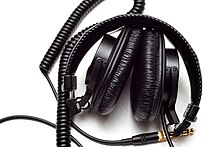
Sony MDR-7506 headphones in stowed configuration

A micro audio amplifier for boosting the output power of smartphones etc. to headphones. Used for example to compensate a built-in volume limit in smartphones, the higher volume levels could, however, lead to ear damage.
Headphones can prevent other people from hearing the sound, either for privacy or to prevent disturbing others, as in listening in a public library. They can also provide a level of sound fidelity greater than loudspeakers of similar cost. Part of their ability to do so comes from the lack of any need to perform room correction treatments with headphones. High-quality headphones can have an extremely flat low-frequency response down to 20 Hz within 3 dB. While a loudspeaker must use a relatively large (often 15″ or 18″) speaker driver to reproduce low frequencies, headphones can accurately reproduce bass and sub-bass frequencies with speaker drivers only 40-50 millimeters wide (or much smaller, as is the case with in-ear monitor headphones). Headphones’ impressive low-frequency performance is possible because they are so much closer to the ear that they only need to move relatively small volumes of air.
Marketed claims such as ‘frequency response 4 Hz to 20 kHz’ are usually overstatements; the product’s response at frequencies lower than 20 Hz is typically very small.[34]
Headphones are also useful for video games that use 3D positional audio processing algorithms, as they allow players to better judge the position of an off-screen sound source (such as the footsteps of an opponent or their gunfire).
Although modern headphones have been particularly widely sold and used for listening to stereo recordings since the release of the Walkman, there is subjective debate regarding the nature of their reproduction of stereo sound. Stereo recordings represent the position of horizontal depth cues (stereo separation) via volume and phase differences of the sound in question between the two channels. When the sounds from two speakers mix, they create the phase difference the brain uses to locate direction. Through most headphones, because the right and left channels do not combine in this manner, the illusion of the phantom center can be perceived as lost. Hard panned sounds are also heard only in one ear rather than from one side.
Binaural recordings use a different microphone technique to encode direction directly as phase, with very little amplitude difference below 2 kHz, often using a dummy head. They can produce a surprisingly lifelike spatial impression through headphones. Commercial recordings almost always use stereo recording, rather than binaural, because loudspeaker listening is more common than headphone listening.
It is possible to change the spatial effects of stereo sound on headphones, to better approximate the presentation of speaker reproduction, by using frequency-dependent cross-feed between the channels.
Headsets can have ergonomic benefits over traditional telephone handsets. They allow call center agents to maintain better posture without needing to hand-hold a handset or tilt their head sideways to cradle it.[35]
Health and safety
Dangers and risks
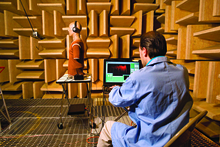
Using headphones at a sufficiently high volume level may cause temporary or permanent hearing impairment or deafness. The headphone volume often has to compete with the background noise, especially in loud places such as subway stations, aircraft, and large crowds. Extended periods of exposure to high sound pressure levels created by headphones at high volume settings may be damaging to hearing;[36][37] Nearly 50% of teenagers and young adults (12 to 35 years old) in middle and high income countries listen to unsafe levels of sound on their personal audio devices and smartphones.[38] However, one hearing expert found in 2012 (before the worldwide adoption of smartphones as the main personal listening devices) that «fewer than 5% of users select volume levels and listen frequently enough to risk hearing loss.»[39] The International Telecommunication Union recently published «Guidelines for safe listening devices/systems» recommended that sound exposure not exceed 80 decibels, A-weighted dB(A) for a maximum of 40 hours per week.[40] The European Union have also set a similar limit for users of personal listening devices (80 dB(A) for no more than 40 hours per week) and for each additional increase of 3-dB in sound exposure, the duration should be cut in half (83 dB(A) for no more than 20 hours, 86 dB(A) for 10 hours per week, 89 dB(A) for 5 hours per week and so on. Most major manufactures of smartphones now include some safety or volume limiting features and warning messaging in their devices.[41][42] though such practices have received mixed response from some segments of the buying who favor the personal choice of setting their own volume levels.
The usual way of limiting sound volume on devices driving headphones is by limiting output power. This has the additional undesirable effect of being dependent of the efficiency of the headphones; a device producing the maximum allowed power may not produce adequate volume when paired with low-efficiency, high-impedance equipment, while the same amount of power can reach dangerous levels with very efficient earphones.
Some studies have found that people are more likely to raise volumes to unsafe levels while performing strenuous exercise.[43] A Finnish study[44] recommended that exercisers should set their headphone volumes to half of their normal loudness and only use them for half an hour.
Other than hearing risk, there is a general danger that listening to loud music in headphones can distract the listener and lead to injury and accidents.[45][46] Noise-cancelling headphones add extra risk. Several countries and states have made it illegal to wear headphones while driving or cycling.[25]
There have also been numerous reports of contact dermatitis due to exposure to in-ear headphones such as Apple AirPods.[47][48] The contact dermatitis would be caused by in-ear headphones that contain gold, rubber, dyes, acrylates, or methacrylates.[47] However, there have been no studies done to prove that exposure to in-ear headphones will cause contact dermatitis, rather that there is a correlation between in-ear headphone use and contact dermatitis cases.[47]
Occupational health and safety
Hearing risk from headphones’ use also applies to workers who must wear electronic or communication headsets as part of their daily job (i.e., pilots, call center and dispatch operators, sound engineers, firefighters, etc.) and hearing damage depends on the exposure time. The National Institute for Occupational Safety and Health (NIOSH) recommends sound exposure not exceed 85 dB(A) over 8 hour work day as a time-weighted average.[49] NIOSH uses the 3-dB exchange rate often referred to as «time-intensity tradeoff» which means if sound exposure level is increased by 3 decibels, the duration of exposure should be cut in half. NIOSH published several documents targeted at protecting the hearing of workers who must wear communication headsets such as call center operators,[50] firefighters,[51] and musicians and sound engineers.[52][53]
See also
- Bone conduction
- Digital audio player
- Earmuffs
- Earpad
- Headphone amplifier
- In-ear monitor
- Loudspeaker
- Noise-cancelling headphones
References
- ^ a b «earphone». Archived from the original on 19 January 2014. Retrieved 4 January 2014.
- ^ Stanley R. Alten Audio Basics Cengage 2011 ISBN 0-495-91356-1 page 63
- ^ «Headphones : The Ultimate buying guide — Hi-fidelity headphones». StereoCompare. Archived from the original on 2016-03-07. Retrieved 2016-03-03.
- ^ «The Ultimate Headphones Buying Guide — Audio Inspects». 2022-06-20. Retrieved 2022-07-15.
- ^ Sullivan, Mark (7 January 2016). «It’s True: Apple Will Drop Headphone Jack To Make The iPhone 7 Slimmer, Says Source». Fast Company. Archived from the original on 2016-08-29.
- ^ «Rewind: How the Walkman changed the world . . «. independent.
- ^ a b «A Partial History of Headphones». Smithsonian Magazine. Retrieved 2020-12-27.
- ^ Heffernan, Virginia (7 January 2011). «Against Headphones». The New York Times. Retrieved 2020-12-27.
- ^ a b Smith, Caspar (30 October 2011). «Now hear this: the history of headphones». The Guardian. Archived from the original on 13 September 2017. Retrieved 13 September 2017.
- ^ «Founded 1958 — World’s First SP/3 Stereophone». koss.com. Archived from the original on 13 September 2017. Retrieved 13 September 2017.
- ^ «Sony history 1960s». Sony official website. Archived from the original on 2016-02-05.
- ^ Description of 3.5mm earphone jack in described model:
«Vintage Sony 1960’S EFM-117J Radio». Retrieved 2016-01-25. - ^ Arce, Nicole (2020-07-22). «How To Use Two Or More Headphones On PC or Mac (Wired/Bluetooth) — Headphonesty». Retrieved 29 May 2021.
- ^ Hearing conservation manual. Hutchison, Thomas L., Schulz, Theresa Y., Council for Accreditation in Occupational Hearing Conservation. (Fifth ed.). Milwaukee, WI. 2014. ISBN 978-0-9863038-0-7. OCLC 940449158.
{{cite book}}: CS1 maint: others (link) - ^ a b c Handbook of clinical audiology. Katz, Jack, Chasin, Marshall, English, Kristina M., 1951-, Hood, Linda J., Tillery, Kim L. (Seventh ed.). Philadelphia. 2015. ISBN 978-1-4511-9163-9. OCLC 877024342.
{{cite book}}: CS1 maint: others (link) - ^ «ANSI/ASA S3.6-2018 — Specification for Audiometers». webstore.ansi.org. Retrieved 2020-11-13.
- ^ «ISO 389-2:1994». ISO. Retrieved 2020-11-13.
- ^ Siau, John. «The «0-Ohm» Headphone Amplifier» (PDF). Archived (PDF) from the original on 10 February 2013. Retrieved 26 June 2012.
- ^ Bohn, Dennis. «Understanding Headphone Power Requirements». HeadWize. Northwestern University. Archived from the original on 2011-06-08.
- ^ «BS EN 50332 tests for headphones and earphones with portable music players». ISVR Consulting. 2 August 2018.
- ^ «Understanding Earphone/Headphone Specifications». Shure Customer Help. Shure. Archived from the original on 2016-06-18.
- ^ a b c Ha, Peter (26 April 2010). «Earbud Review: Best Headphones for Price, Hearing Safety — TIME». TIME.com. Archived from the original on 17 August 2013. Retrieved 21 July 2015.
- ^ Fligor, Brian J.; Cox, L. Clarke (December 2004). «Output Levels of Commercially Available Portable Compact Disc Players and the Potential Risk to Hearing». Ear and Hearing. 25 (6): 513–27. doi:10.1097/00003446-200412000-00001. PMID 15604913. S2CID 11043107. Retrieved 21 July 2015.
- ^ Engber, Daniel (16 May 2014). «Who Made That Earbud?». The New York Times Magazine. Archived from the original on 2017-02-02.
- ^ a b «Headphones as a Driving Distraction» (PDF). The Royal Society for the Prevention of Accidents. Archived (PDF) from the original on 15 September 2017. Retrieved 14 September 2017.
- ^ «Use Ambient sound on your Samsung earbuds». Samsung Electronics America. Retrieved 2021-08-13.
- ^ «WF-1000XM3 | Help Guide | Listening to ambient sound during music playback (Ambient Sound Mode)». helpguide.sony.net. Retrieved 2021-08-13.
- ^ «Lightspeed Aviation 30 3G Discontinued Aviation Headset». lightspeedaviation.com. Retrieved 26 Dec 2020.
- ^ Hertsens, Tyll (2014-12-15). «How Balanced Armature Receivers/Drivers Work». InnerFidelity. Archived from the original on 2015-09-14.
- ^ Joel, Amos E. (1975). A History of Engineering and Science in the Bell System: The early years (1875-1925). The Laboratories. ISBN 9780608080666.
- ^ Yang Wei; Xiaoyang Lin; Kaili Jiang; Peng Liu; Qunqing Li; Shoushan Fan (2013). «Thermoacoustic Chips with Carbon Nanotube Thin Yarn Arrays». Nano Letters. 13 (10): 4795–801. Bibcode:2013NanoL..13.4795W. doi:10.1021/nl402408j. PMID 24041369.
- ^ «Plasmasonic». La Nouvelle Revue Du Son. FR. March 1984. p. 100.
- ^ US 4460809A, Henri Bondar, «Process and device for converting a periodic LF electric voltage into sound waves»
- ^ «How to buy headphones». CNET. Archived from the original on 2011-08-20.
Even the flimsiest, cheap headphones routinely boast extremely low bass-response performance—15 or 20Hz—but almost always sound lightweight and bright.
- ^ United States Department of Labor. Occupational Safety & Health Administration. Computer Workstation. Checklist. Archived 2009-02-02 at the Wayback Machine Accessed February 2, 2009.
- ^ «Causes of Hearing Loss in Adults». asha.org. Archived from the original on 13 December 2010. Retrieved 21 July 2015.
- ^ «Noise-Induced Hearing Loss». nih.gov. Archived from the original on 9 May 2016. Retrieved 21 July 2015.
- ^ World Health Organization (15 Mar 2018). «1.1 billion people at risk of hearing loss». Archived from the original on February 27, 2015. Retrieved 2 Feb 2019.
- ^ William W. Clark. «Five Myths in Assessing the Effects of Noise on Hearing». AudiologyOnline. Archived from the original on 24 September 2012. Retrieved 21 July 2015.
- ^ «H.870 : Guidelines for safe listening devices/systems». www.itu.int. Retrieved 2019-02-28.
- ^ «Sound and Hearing». Apple. Retrieved 2019-02-28.
- ^ «Limit Media Volume». Samsung Electronics America. Retrieved 2019-02-28.
- ^ «Can Loud Noise during Exercise Damage my Hearing?». Healthy Hearing. Item 4. Archived from the original on 9 November 2014. Retrieved 8 November 2014.
{{cite web}}: CS1 maint: location (link) - ^ Airo, Erkko; J. Pekkarinen; P. Olkinuora. «Listening to music with earphones: an assessment of noise exposure,» Acustica–Acta Acustica, pp. 82, 885–894. (1996)
- ^ Greenfield, Paige (25 June 2011). «Deaf to Danger: The Perils of Earbuds». ABC News. Archived from the original on 14 December 2013. Retrieved 20 June 2013.
- ^ Lichenstein, R; Smith, DC; Ambrose, JL; Moody, LA (October 2012). «Headphone use and pedestrian injury and death in the United States: 2004-2011». Injury Prevention. 18 (5): 287–90. doi:10.1136/injuryprev-2011-040161. PMID 22248915. S2CID 25177965.
- ^ a b c Hayakawa, Michitaro; Suzuki, Chihiro; Zhu, Yingyao; Anzai, Hidemi (April 2022). «Allergic contact dermatitis to gold in the parts of in‐ear headphones». Contact Dermatitis. 86 (4): 328–330. doi:10.1111/cod.14036. ISSN 0105-1873. PMID 34978717. S2CID 245651803.
- ^ Chan, Justin; Rabi, Sina; Adler, Brandon L. (November 2021). «Allergic Contact Dermatitis to (Meth)Acrylates in Apple AirPods Headphones». Dermatitis. 32 (6): e111–e112. doi:10.1097/DER.0000000000000735. ISSN 2162-5220. PMID 34807535. S2CID 233923350.
- ^ «Criteria for a recommended standard… occupational noise exposure, revised criteria 1998». 2018-10-16. doi:10.26616/NIOSHPUB98126.
- ^ «Reducing noise hazards for call and dispatch center operators». 2018-12-19. doi:10.26616/NIOSHPUB2011210.
- ^ «Promoting hearing health among fire fighters». 2018-12-19. doi:10.26616/NIOSHPUB2013142.
- ^ «Reducing the risk of hearing disorders among musicians». 2018-12-19. doi:10.26616/NIOSHPUB2015184.
- ^ McGinnity, Siobhan; Beach, Elizabeth Francis; Cowan, Robert S. C.; Mulder, Johannes (2020-10-22). «The hearing health of live-music sound engineers». Archives of Environmental & Occupational Health. 76 (6): 301–312. doi:10.1080/19338244.2020.1828241. ISSN 2154-4700. PMID 33089760. S2CID 224821849.
External links


Headphones are a pair of small loudspeaker drivers worn on or around the head over a user’s ears. They are electroacoustic transducers, which convert an electrical signal to a corresponding sound. Headphones let a single user listen to an audio source privately, in contrast to a loudspeaker, which emits sound into the open air for anyone nearby to hear. Headphones are also known as earspeakers, earphones[1] or, colloquially, cans.[2] Circumaural (‘around the ear’) and supra-aural (‘over the ear’) headphones use a band over the top of the head to hold the speakers in place. Another type, known as earbuds or earpieces[1] consist of individual units that plug into the user’s ear canal. A third type are bone conduction headphones, which typically wrap around the back of the head and rest in front of the ear canal, leaving the ear canal open. In the context of telecommunication, a headset is a combination of headphone and microphone.
Headphones connect to a signal source such as an audio amplifier, radio, CD player, portable media player, mobile phone, video game console, or electronic musical instrument, either directly using a cord, or using wireless technology such as Bluetooth, DECT or FM radio. The first headphones were developed in the late 19th century for use by telephone operators, to keep their hands free. Initially the audio quality was mediocre and a step forward was the invention of high fidelity headphones.[3][4]
Headphones exhibit a range of different audio reproduction quality capabilities. Headsets designed for telephone use typically cannot reproduce sound with the high fidelity of expensive units designed for music listening by audiophiles. Headphones that use cables typically have either a 1/4 inch (6.35mm) or 1/8 inch (3.5mm) phone jack for plugging the headphones into the audio source. Some stereo earbuds are wireless, using Bluetooth connectivity to transmit the audio signal by radio waves from source devices like cellphones and digital players.[5] As a result of the Walkman effect, beginning in the 1980s, headphones started to be used in public places such as sidewalks, grocery stores, and public transit.[6] Headphones are also used by people in various professional contexts, such as audio engineers mixing sound for live concerts or sound recordings and DJs, who use headphones to cue up the next song without the audience hearing, aircraft pilots and call center employees. The latter two types of employees use headphones with an integrated microphone.
History
Headphones grew out of the need to free up a person’s hands when operating a telephone. There were several iterative products that were predecessors to the «hands-free» headphones. By the 1890s the first device that is unmistakably a headphone was made by a British company called Electrophone, which created a system allowing their customers to connect into live feeds of performances at theaters and opera houses across London. Subscribers to the service could listen to the performance through a pair of massive earphones that connected below the chin, held by a long rod.[7]
French engineer Ernest Mercadier patented a set of in-ear headphones in 1891, Mercadier was awarded U.S. Patent No. 454,138 for “improvements in telephone-receivers…which shall be light enough to be carried while in use on the head of the operator.[7]”
Nathaniel Baldwin of Utah in 1910 invented a prototype telephone headset due to his inability to hear sermons during Sunday service. He offered it for testing to the US Navy, which promptly ordered 100 from Baldwin. Wireless Specialty Apparatus Co., in partnership with Baldwin Radio Company, set up a manufacturing facility in Utah to fulfill orders. His innovations were the basis of “sound-powered” telephones or phones that required no electricity, which were used during World War II.[8]

Brandes radio headphones, circa 1920
Headphones originated from the telephone receiver earpiece, and were the only way to listen to electrical audio signals before amplifiers were developed.
These early headphones used moving iron drivers,[9] with either single-ended or balanced armatures. The common single-ended type used voice coils wound around the poles of a permanent magnet, which were positioned close to a flexible steel diaphragm. The audio current through the coils varied the magnetic field of the magnet, exerting a varying force on the diaphragm, causing it to vibrate, creating sound waves. The requirement for high sensitivity meant that no damping was used, so the frequency response of the diaphragm had large peaks due to resonance, resulting in poor sound quality. These early models lacked padding, and were often uncomfortable to wear for long periods. Their impedance varied; headphones used in telegraph and telephone work had an impedance of 75 ohms. Those used with early wireless radio had more turns of finer wire to increase sensitivity. Impedance of 1,000 to 2,000 ohms was common, which suited both crystal sets and triode receivers. Some very sensitive headphones, such as those manufactured by Brandes around 1919, were commonly used for early radio work.
In early powered radios, the headphone was part of the vacuum tube’s plate circuit and carried dangerous voltages. It was normally connected directly to the positive high voltage battery terminal, and the other battery terminal was securely grounded. The use of bare electrical connections meant that users could be shocked if they touched the bare headphone connections while adjusting an uncomfortable headset.
In 1958, John C. Koss, an audiophile and jazz musician from Milwaukee, produced the first stereo headphones.[10][9]
Smaller earbud type earpieces, which plugged into the user’s ear canal, were first developed for hearing aids. They became widely used with transistor radios, which commercially appeared in 1954 with the introduction of the Regency TR-1. The most popular audio device in history, the transistor radio changed listening habits, allowing people to listen to radio anywhere. The earbud uses either a moving iron driver or a piezoelectric crystal to produce sound. The 3.5 mm radio and phone connector, which is the most commonly used in portable application today, has been used at least since the Sony EFM-117J transistor radio, which was released in 1964.[11][12] Its popularity was reinforced with its use on the Walkman portable tape player in 1979.
Applications
Headphones may be used with stationary CD and DVD players, home theater, personal computers, or portable devices (e.g., digital audio player/MP3 player, mobile phone), as long as these devices are equipped with a headphone jack. Cordless headphones are not connected to their source by a cable. Instead, they receive a radio or infrared signal encoded using a radio or infrared transmission link, such as FM, Bluetooth or Wi-Fi. These are battery-powered receiver systems, of which the headphone is only a component. Cordless headphones are used with events such as a Silent disco or Silent Gig.

In the professional audio sector, headphones are used in live situations by disc jockeys with a DJ mixer, and sound engineers for monitoring signal sources. In radio studios, DJs use a pair of headphones when talking to the microphone while the speakers are turned off to eliminate acoustic feedback while monitoring their own voice. In studio recordings, musicians and singers use headphones to play or sing along to a backing track or band. In military applications, audio signals of many varieties are monitored using headphones.
Wired headphones are attached to an audio source by a cable. The most common connectors are 6.35 mm (1⁄4 inch) and 3.5 mm phone connectors. The larger 6.35 mm connector is more common on fixed location home or professional equipment. The 3.5 mm connector remains the most widely used connector for portable application today. Adapters are available for converting between 6.35 mm and 3.5 mm devices.
As active component, wireless headphones tend to be costlier due to the necessity for internal hardware such as a battery, a charging controller, a speaker driver, and a wireless transceiver, whereas wired headphones are a passive component, outsourcing speaker driving to the audio source.
Some headphone cords are equipped with a serial potentiometer for volume control.
Wired headphones may be equipped with a non-detachable cable or a detachable auxiliary male-to-male plug, as well as some with two ports to allow connecting another wired headphone in a parallel circuit, which splits the audio signal to share with another participant, but can also be used to hear audio from two inputs simultaneously. An external audio splitter can retrofit this ability.[13]
Applications for audiometric testing
Various types of specially designed headphones or earphones are also used to evaluate the status of the auditory system in the field of audiology for establishing hearing thresholds, medically diagnosing hearing loss, identifying other hearing related disease, and monitoring hearing status in occupational hearing conservation programs.[14] Specific models of headphones have been adopted as the standard due to the ease of calibration and ability to compare results between testing facilities.[15]
Supra-aural style headphones are historically the most commonly used in audiology as they are the easiest to calibrate and were considered the standard for many years. Commonly used models are the Telephonics Dynamic Headphone (TDH) 39, TDH-49, and TDH-50. In-the-ear or insert style earphones are used more commonly today as they provide higher levels of interaural attenuation, introduce less variability when testing 6,000 and 8,000 Hz, and avoid testing issues resulting from collapsed ear canals. A commonly used model of insert earphone is the Etymotic Research ER-3A. Circum-aural earphones are also used to establish hearing thresholds in the extended high frequency range (8,000 Hz to 20,000 kHz). Along with Etymotic Research ER-2A insert earphones, the Sennheiser HDA300 and Koss HV/1A circum-aural earphones are the only models that have reference equivalent threshold sound pressure level values for the extended high frequency range as described by ANSI standards.[16][15][17]
Audiometers and headphones must be calibrated together. During the calibration process, the output signal from the audiometer to the headphones is measured with a sound level meter to ensure that the signal is accurate to the reading on the audiometer for sound pressure level and frequency. Calibration is done with the earphones in an acoustic coupler that is intended to mimic the transfer function of the outer ear. Because specific headphones are used in the initial audiometer calibration process, they cannot be replaced with any other set of headphones, even from the same make and model.[15]
Electrical characteristics
Electrical characteristics of dynamic loudspeakers may be readily applied to headphones, because most headphones are small dynamic loudspeakers.
Impedance
Headphones are available with high or low impedance (typically measured at 1 kHz). Low-impedance headphones are in the range 16 to 32 ohms and high-impedance headphones are about 100-600 ohms. As the impedance of a pair of headphones increases, more voltage (at a given current) is required to drive it, and the loudness of the headphones for a given voltage decreases. In recent years, impedance of newer headphones has generally decreased to accommodate lower voltages available on battery powered CMOS-based portable electronics. This has resulted in headphones that can be more efficiently driven by battery-powered electronics. Consequently, newer amplifiers are based on designs with relatively low output impedance.
The impedance of headphones is of concern because of the output limitations of amplifiers. A modern pair of headphones is driven by an amplifier, with lower impedance headphones presenting a larger load. Amplifiers are not ideal; they also have some output impedance that limits the amount of power they can provide. To ensure an even frequency response, adequate damping factor, and undistorted sound, an amplifier should have an output impedance less than 1/8 that of the headphones it is driving (and ideally, as low as possible). If output impedance is large compared to the impedance of the headphones, significantly higher distortion is present.[18] Therefore, lower impedance headphones tend to be louder and more efficient, but also demand a more capable amplifier. Higher impedance headphones are more tolerant of amplifier limitations, but produce less volume for a given output level.
Historically, many headphones had relatively high impedance, often over 500 ohms so they could operate well with high-impedance tube amplifiers. In contrast, modern transistor amplifiers can have very low output impedance, enabling lower-impedance headphones. Unfortunately, this means that older audio amplifiers or stereos often produce poor-quality output on some modern, low-impedance headphones. In this case, an external headphone amplifier may be beneficial.
Sensitivity
Sensitivity is a measure of how effectively an earpiece converts an incoming electrical signal into an audible sound. It thus indicates how loud the headphones are for a given electrical drive level. It can be measured in decibels of sound pressure level per milliwatt (dB (SPL)/mW) or decibels of sound pressure level per volt (dB (SPL) / V).[19] Unfortunately, both definitions are widely used, often interchangeably. As the output voltage (but not power) of a headphone amplifier is essentially constant for most common headphones, dB/mW is often more useful if converted into dB/V using Ohm’s law:
Once the sensitivity per volt is known, the maximum volume for a pair of headphones can be easily calculated from the maximum amplifier output voltage. For example, for a headphone with a sensitivity of 100 dB (SPL)/V, an amplifier with an output of 1 root mean square (RMS) voltage produces a maximum volume of 100 dB.
Pairing high-sensitivity headphones with power amplifiers can produce dangerously high volumes and damage headphones. The maximum sound pressure level is a matter of preference, with some sources recommending no higher than 110 to 120 dB. In contrast, the American Occupational Safety and Health Administration recommends an average SPL of no more than 85 dB(A) to avoid long-term hearing loss, while the European Union standard EN 50332-1:2013 recommends that volumes above 85 dB(A) include a warning, with an absolute maximum volume (defined using 40–4,000 Hz noise) of no more than 100 dB to avoid accidental hearing damage.[20] Using this standard, headphones with sensitivities of 90, 100 and 110 dB (SPL)/V should be driven by an amplifier capable of no more than 3.162, 1.0 and 0.3162 RMS volts at maximum volume setting, respectively to reduce the risk of hearing damage.
The sensitivity of headphones is usually between about 80 and 125 dB/mW and usually measured at 1 kHz.[21]
Specifications
Headphone size can affect the balance between fidelity and portability. Generally, headphone form factors can be divided into four separate categories: circumaural (over-ear), supra-aural (on-ear), earbud and in-ear.
Connectivity
Wired
Headphones with soldered headphone jack cables.
Wireless
- Wireless on-ear headphones. Often have an inbuilt headphone jack.
- Wireless over-ear headphones. Often have an inbuilt headphone jack.
- Wireless earphones connected via a neckband.
True wireless
True wireless earbuds have no cord to keep each bud connected to each other. They rely on wireless technology such as Bluetooth to transmit audio from a hardware device.
Ear adaption
Circumaural

Circumaural headphones have large pads that surround the outer ear.
Circumaural headphones (sometimes called full size headphones or over-ear headphones) have circular or ellipsoid earpads that encompass the ears. Because these headphones completely surround the ear, circumaural headphones can be designed to fully seal against the head to attenuate external noise. Because of their size, circumaural headphones can be heavy and there are some sets that weigh over 500 grams (1 lb). Ergonomic headband and earpad design is required to reduce discomfort resulting from weight. These are commonly used by drummers in recording.
Supra-aural

A pair of supra-aural (on-ear) headphones
Supra-aural headphones or on-ear headphones have pads that press against the ears, rather than around them. They were commonly bundled with personal stereos during the 1980s. This type of headphone generally tends to be smaller and lighter than circumaural headphones, resulting in less attenuation of outside noise. Supra-aural headphones can also lead to discomfort due to the pressure on the ear as compared to circumaural headphones that sit around the ear. Comfort may vary due to the earcup material.
Ear-fitting headphones
Earphones
Earphones sit in the outer ear.
Earphones are very small headphones that are fitted directly in the outer ear, facing but not inserted in the ear canal. Earphones are portable and convenient, but many people consider them uncomfortable.[22] They provide hardly any acoustic isolation and leave room for ambient noise to seep in; users may turn up the volume dangerously high to compensate, at the risk of causing hearing loss.[22][23] On the other hand, they let the user be better aware of their surroundings. Since the early days of the transistor radio, earphones have commonly been bundled with personal music devices. They are sold at times with foam or rubber pads for comfort. (The use of the term earbuds, which has been around since at least 1984, did not hit its peak until after 2001, with the success of Apple’s MP3 player.[24])
In-ear headphones

In-ear monitors extend into the ear canal, providing isolation from outside noise.
In-ear headphones, also known as in-ear monitors (IEMs) or canalphones, are small headphones with similar portability to earbuds that are inserted in the ear canal itself. IEMs are higher-quality in-ear headphones and are used by audio engineers and musicians as well as audiophiles.
The outer shells of in-ear headphones are made up of a variety of materials, such as plastic, aluminum, ceramic and other metal alloys. Because in-ear headphones engage the ear canal, they can be prone to sliding out, and they block out much environmental noise. Lack of sound from the environment can be a problem when sound is a necessary cue for safety or other reasons, as when walking, driving, or riding near or in vehicular traffic.[25] Some in-ear headphones utilize built-in microphones to allow some outside sound to be heard when desired.[26][27]
Generic or custom-fitting ear canal plugs are made from silicone rubber, elastomer, or foam. Such plugs in lower-end devices may be interchangeable, which increases the risk of them falling off and getting lodged in the ear canal. Custom in-ear headphones use castings of the ear canal to create custom-molded plugs that provide added comfort and noise isolation.[22]
Some wireless earphones include a charging case.
Open- or closed-back
Both circumaural and supra-aural headphones can be further differentiated by the type of earcups:
Open-back
Open-back headphones have the back of the earcups open. This leaks more sound out of the headphone and also lets more ambient sounds into the headphone, but gives a more natural or speaker-like sound, due to including sounds from the environment.
Semi-open
Semi-open headphones, have a design that can be considered as a compromise between open-back headphones and closed-back headphones. Some[who?] believe the term «semi-open» is purely there for marketing purposes. There is no exact definition for the term semi-open headphone. Where the open-back approach has hardly any measure to block sound at the outer side of the diaphragm and the closed-back approach really has a closed chamber at the outer side of the diaphragm, a semi-open headphone can have a chamber to partially block sound while letting some sound through via openings or vents.
Closed-back
Closed-back (or sealed) styles have the back of the earcups closed. They usually block some of the ambient noise. Closed-back headphones usually can produce stronger low frequencies than open-back headphones.
Headset

A headset is a headphone combined with a microphone. Headsets provide the equivalent functionality of a telephone handset with hands-free operation. Among applications for headsets, besides telephone use, are aviation, theatre or television studio intercom systems, and console or PC gaming. Headsets are made with either a single-earpiece (mono) or a double-earpiece (mono to both ears or stereo). The microphone arm of headsets is either an external microphone type where the microphone is held in front of the user’s mouth, or a voicetube type where the microphone is housed in the earpiece and speech reaches it by means of a hollow tube.
Telephone headsets

Telephone headsets connect to a fixed-line telephone system. A telephone headset functions by replacing the handset of a telephone. Headsets for standard corded telephones are fitted with a standard 4P4C commonly called an RJ-9 connector. Headsets are also available with 2.5 mm jack sockets for many DECT phones and other applications. Cordless bluetooth headsets are available, and often used with mobile telephones. Headsets are widely used for telephone-intensive jobs, in particular by call centre workers. They are also used by anyone wishing to hold telephone conversations with both hands free.
For older models of telephones, the headset microphone impedance is different from that of the original handset, requiring a telephone amplifier for the telephone headset. A telephone amplifier provides basic pin-alignment similar to a telephone headset adaptor, but it also offers sound amplification for the microphone as well as the loudspeakers. Most models of telephone amplifiers offer volume control for loudspeaker as well as microphone, mute function and switching between headset and handset. Telephone amplifiers are powered by batteries or AC adaptors.
Communication headsets

Communication headsets are used for two-way communication and typically consist of a headphone and attached microphone. Such headsets are used in a variety of professions as aviation, military, sports, music, and many service-oriented sectors. They come in all shapes and sizes, depending on use, required noise attenuation, and fidelity of communication needed.
Ambient noise reduction
Unwanted sound from the environment can be reduced by excluding sound from the ear by passive noise isolation, or, often in conjunction with isolation, by active noise cancellation.

In-ears are among those good for noise isolation.
Passive noise isolation is essentially using the body of the earphone, either over or in the ear, as a passive earplug that simply blocks out sound. The headphone types that provide most attenuation are in-ear canal headphones and closed-back headphones, both circumaural and supra aural. Open-back and earbud headphones provide some passive noise isolation, but much less than the others. Typical closed-back headphones block 8 to 12 dB, and in-ears anywhere from 10 to 15 dB. Some models have been specifically designed for drummers to facilitate the drummer monitoring the recorded sound while reducing sound directly from the drums as much as possible. Such headphones claim to reduce ambient noise by around 25 dB.
Active noise-cancelling headphones use a microphone, amplifier, and speaker to pick up, amplify, and play ambient noise in phase-reversed form; this to some extent cancels out unwanted noise from the environment without affecting the desired sound source, which is not picked up and reversed by the microphone. They require a power source, usually a battery, to drive their circuitry. Active noise cancelling headphones can attenuate ambient noise by 20 dB or more, but the active circuitry is mainly effective on constant sounds and at lower frequencies, rather than sharp sounds and voices. Some noise cancelling headphones are designed mainly to reduce low-frequency engine and travel noise in aircraft, trains, and automobiles, and are less effective in environments with other types of noise.
Transducer technology
Headphones use various types of transducer to convert electrical signals to sound.
Moving-coil

A typical moving-coil headphone transducer
The moving coil driver, more commonly referred to as a «dynamic» driver is the most common type used in headphones. It consists of a stationary magnet element affixed to the frame of the headphone, which sets up a static magnetic field. The magnet in headphones is typically composed of ferrite or neodymium. A voice coil, a light coil of wire, is suspended in the magnetic field of the magnet, attached to a diaphragm, typically fabricated from lightweight, high-stiffness-to-mass-ratio cellulose, polymer, carbon material, paper or the like. When the varying current of an audio signal is passed through the coil, it creates a varying magnetic field that reacts against the static magnetic field, exerting a varying force on the coil causing it and the attached diaphragm to vibrate. The vibrating diaphragm pushes on the air to produce sound waves.
Electrostatic

Electrostatic loudspeaker diagram
Electrostatic drivers consist of a thin, electrically charged diaphragm, typically a coated PET film membrane, suspended between two perforated metal plates (electrodes). The electrical sound signal is applied to the electrodes creating an electrical field; depending on the polarity of this field, the diaphragm is drawn towards one of the plates. Air is forced through the perforations; combined with a continuously changing electrical signal driving the membrane, a sound wave is generated. Electrostatic headphones are usually more expensive than moving-coil ones, and are comparatively uncommon. In addition, a special amplifier is required to amplify the signal to deflect the membrane, which often requires electrical potentials in the range of 100 to 1,000 volts.
Due to the extremely thin and light diaphragm membrane, often only a few micrometers thick, and the complete absence of moving metalwork, the frequency response of electrostatic headphones usually extends well above the audible limit of approximately 20 kHz. The high-frequency response means that the low-midband distortion level is maintained to the top of the audible frequency band, which is generally not the case with moving coil drivers. Also, the frequency response peakiness regularly seen in the high-frequency region with moving coil drivers is absent. Well-designed electrostatic headphones can produce significantly better sound quality than other types.[citation needed]
Electrostatic headphones require a voltage source generating 100 V to over 1 kV, and are on the user’s head. Since the invention of insulators, there is no actual danger. They do not need to deliver significant electric current, which further limits the electrical hazard to the wearer in case of fault.
Electret
An electret driver functions along the same electromechanical means as an electrostatic driver. However the electret driver has a permanent charge built into it, whereas electrostatics have the charge applied to the driver by an external generator. Electret and electrostatic headphones are relatively uncommon. Original electrets were also typically cheaper and lower in technical capability and fidelity than electrostatics. Patent applications from 2009 to 2013 have been approved that show by using different materials, i.e. a «Fluorinated cyclic olefin electret film», Frequency response chart readings can reach 50 kHz at 100db. When these new improved electrets are combined with a traditional dome headphone driver, headphones can be produced that are recognised by the Japan Audio Society as worthy of joining the Hi Res Audio program. US patents 8,559,660 B2. 7,732,547 B2.7,879,446 B2.7,498,699 B2.
Planar magnetic
Planar magnetic (also known as orthodynamic) headphones use similar technology to electrostatic headphones, with some fundamental differences. They operate similarly to planar magnetic loudspeakers.
A planar magnetic driver consists of a relatively large membrane that contains an embedded wire pattern. This membrane is suspended between two sets of permanent, oppositely aligned, magnets. A current passed through the wires embedded in the membrane produces a magnetic field that reacts with the field of the permanent magnets to induce movement in the membrane, which produces sound.
Balanced armature
Armature balanced and exerting no force on diaphragm
Armature torqued and exerting a force on diaphragm
A balanced armature is a sound transducer design primarily intended to increase the electrical efficiency of the element by eliminating the stress on the diaphragm characteristic of many other magnetic transducer systems. As shown schematically in the left diagram, it consists of a moving magnetic armature that is pivoted so it can move in the field of the permanent magnet. When precisely centered in the magnetic field there is no net force on the armature, hence the term ‘balanced’. As illustrated in the right diagram, when there is electric current through the coil, it magnetizes the armature one way or the other, causing it to rotate slightly one way or the other about the pivot thus moving the diaphragm to make sound.

A custom in-ear monitor which uses 8 balanced armatures in a triple crossover configuration (4 low/2 mid/2 high). Headphone designs often use multiple balanced armatures to provide a higher fidelity sound.
The design is not mechanically stable; a slight imbalance makes the armature stick to one pole of the magnet. A fairly stiff restoring force is required to hold the armature in the ‘balance’ position. Although this reduces its efficiency, this design can still produce more sound from less power than any other.[clarification needed] Popularized in the 1920s as Baldwin Mica Diaphragm radio headphones, balanced armature transducers were refined during World War II for use in military sound powered telephones. Some of these achieved astonishing electro-acoustic conversion efficiencies, in the range of 20% to 40%, for narrow bandwidth voice signals.
Today they are typically used only in in-ear headphones and hearing aids, where their high efficiency and diminutive size is a major advantage.[29] They generally are limited at the extremes of the hearing spectrum (e.g. below 20 Hz and above 16 kHz) and require a better seal than other types of drivers to deliver their full potential. Higher-end models may employ multiple armature drivers, dividing the frequency ranges between them using a passive crossover network. A few combine an armature driver with a small moving-coil driver for increased bass output.
The earliest loudspeakers for radio receivers used balanced armature drivers for their cones.[30]
Thermoacoustic technology
The thermoacoustic effect generates sound from the audio frequency Joule heating of the conductor, an effect that is not magnetic and does not vibrate the speaker.
In 2013 a carbon nanotube thin-yarn earphone based on the thermoacoustic mechanism was demonstrated by a research group in Tsinghua University.[31] The as-produced CNT thin yarn earphone has a working element called CNT thin yarn thermoacoustic chip. Such a chip is composed of a layer of CNT thin yarn array supported by the silicon wafer, and periodic grooves with certain depth are made on the wafer by micro-fabrication methods to suppress the heat leakage from the CNT yarn to the substrate.[citation needed]
Other transducer technologies
Transducer technologies employed much less commonly for headphones include the Heil Air Motion Transformer (AMT); Piezoelectric film; Ribbon planar magnetic; Magnetostriction and Plasma or Ionic. The first Heil AMT headphone was marketed by ESS Laboratories and was essentially an ESS AMT tweeter from one of the company’s speakers being driven at full range. Since the turn of the century, only Precide of Switzerland have manufactured an AMT headphone. Piezoelectric film headphones were first developed by Pioneer, their two models used a flat sheet of film that limited the maximum volume of air movement. Currently, TakeT produces a piezoelectric film headphone shaped similarly to an AMT transducer but, which like the Precide driver, has a variation in the size of transducer folds over the diaphragm. It additionally incorporates a two way design by its inclusion of a dedicated tweeter/supertweeter panel. The folded shape of a diaphragm allows a transducer with a larger surface area to fit within smaller space constraints. This increases the total volume of air that can be moved on each excursion of the transducer given that radiating area. Due to the small volume of air in a headphone, the plasma or ionic transducer can become a full range driver although the high temperatures and voltages of these types makes them very rare with only the Plasmasonic being commercial.
Magnetostriction headphones, sometimes sold under the label Bonephones, work by vibrating against the side of head, transmitting sound via bone conduction. This is particularly helpful in situations where the ears must be unobstructed, or for people who are deaf for reasons that don’t affect the nervous apparatus of hearing. Magnetostriction headphones though, are limited in their fidelity compared to conventional headphones that rely on the normal workings of the ear. Additionally, in the mid 1980s, a French company called Audio Reference tried to market the Plasmasonic plasma headphone invented by Henri Bondar.[32][33] There are no known functioning examples left. Due to the small volume of air in a headphone, the plasma or ionic transducer can become a full range driver although the high temperatures and voltages needed makes them very rare.
Benefits and limitations

Sony MDR-7506 headphones in stowed configuration

A micro audio amplifier for boosting the output power of smartphones etc. to headphones. Used for example to compensate a built-in volume limit in smartphones, the higher volume levels could, however, lead to ear damage.
Headphones can prevent other people from hearing the sound, either for privacy or to prevent disturbing others, as in listening in a public library. They can also provide a level of sound fidelity greater than loudspeakers of similar cost. Part of their ability to do so comes from the lack of any need to perform room correction treatments with headphones. High-quality headphones can have an extremely flat low-frequency response down to 20 Hz within 3 dB. While a loudspeaker must use a relatively large (often 15″ or 18″) speaker driver to reproduce low frequencies, headphones can accurately reproduce bass and sub-bass frequencies with speaker drivers only 40-50 millimeters wide (or much smaller, as is the case with in-ear monitor headphones). Headphones’ impressive low-frequency performance is possible because they are so much closer to the ear that they only need to move relatively small volumes of air.
Marketed claims such as ‘frequency response 4 Hz to 20 kHz’ are usually overstatements; the product’s response at frequencies lower than 20 Hz is typically very small.[34]
Headphones are also useful for video games that use 3D positional audio processing algorithms, as they allow players to better judge the position of an off-screen sound source (such as the footsteps of an opponent or their gunfire).
Although modern headphones have been particularly widely sold and used for listening to stereo recordings since the release of the Walkman, there is subjective debate regarding the nature of their reproduction of stereo sound. Stereo recordings represent the position of horizontal depth cues (stereo separation) via volume and phase differences of the sound in question between the two channels. When the sounds from two speakers mix, they create the phase difference the brain uses to locate direction. Through most headphones, because the right and left channels do not combine in this manner, the illusion of the phantom center can be perceived as lost. Hard panned sounds are also heard only in one ear rather than from one side.
Binaural recordings use a different microphone technique to encode direction directly as phase, with very little amplitude difference below 2 kHz, often using a dummy head. They can produce a surprisingly lifelike spatial impression through headphones. Commercial recordings almost always use stereo recording, rather than binaural, because loudspeaker listening is more common than headphone listening.
It is possible to change the spatial effects of stereo sound on headphones, to better approximate the presentation of speaker reproduction, by using frequency-dependent cross-feed between the channels.
Headsets can have ergonomic benefits over traditional telephone handsets. They allow call center agents to maintain better posture without needing to hand-hold a handset or tilt their head sideways to cradle it.[35]
Health and safety
Dangers and risks

Using headphones at a sufficiently high volume level may cause temporary or permanent hearing impairment or deafness. The headphone volume often has to compete with the background noise, especially in loud places such as subway stations, aircraft, and large crowds. Extended periods of exposure to high sound pressure levels created by headphones at high volume settings may be damaging to hearing;[36][37] Nearly 50% of teenagers and young adults (12 to 35 years old) in middle and high income countries listen to unsafe levels of sound on their personal audio devices and smartphones.[38] However, one hearing expert found in 2012 (before the worldwide adoption of smartphones as the main personal listening devices) that «fewer than 5% of users select volume levels and listen frequently enough to risk hearing loss.»[39] The International Telecommunication Union recently published «Guidelines for safe listening devices/systems» recommended that sound exposure not exceed 80 decibels, A-weighted dB(A) for a maximum of 40 hours per week.[40] The European Union have also set a similar limit for users of personal listening devices (80 dB(A) for no more than 40 hours per week) and for each additional increase of 3-dB in sound exposure, the duration should be cut in half (83 dB(A) for no more than 20 hours, 86 dB(A) for 10 hours per week, 89 dB(A) for 5 hours per week and so on. Most major manufactures of smartphones now include some safety or volume limiting features and warning messaging in their devices.[41][42] though such practices have received mixed response from some segments of the buying who favor the personal choice of setting their own volume levels.
The usual way of limiting sound volume on devices driving headphones is by limiting output power. This has the additional undesirable effect of being dependent of the efficiency of the headphones; a device producing the maximum allowed power may not produce adequate volume when paired with low-efficiency, high-impedance equipment, while the same amount of power can reach dangerous levels with very efficient earphones.
Some studies have found that people are more likely to raise volumes to unsafe levels while performing strenuous exercise.[43] A Finnish study[44] recommended that exercisers should set their headphone volumes to half of their normal loudness and only use them for half an hour.
Other than hearing risk, there is a general danger that listening to loud music in headphones can distract the listener and lead to injury and accidents.[45][46] Noise-cancelling headphones add extra risk. Several countries and states have made it illegal to wear headphones while driving or cycling.[25]
There have also been numerous reports of contact dermatitis due to exposure to in-ear headphones such as Apple AirPods.[47][48] The contact dermatitis would be caused by in-ear headphones that contain gold, rubber, dyes, acrylates, or methacrylates.[47] However, there have been no studies done to prove that exposure to in-ear headphones will cause contact dermatitis, rather that there is a correlation between in-ear headphone use and contact dermatitis cases.[47]
Occupational health and safety
Hearing risk from headphones’ use also applies to workers who must wear electronic or communication headsets as part of their daily job (i.e., pilots, call center and dispatch operators, sound engineers, firefighters, etc.) and hearing damage depends on the exposure time. The National Institute for Occupational Safety and Health (NIOSH) recommends sound exposure not exceed 85 dB(A) over 8 hour work day as a time-weighted average.[49] NIOSH uses the 3-dB exchange rate often referred to as «time-intensity tradeoff» which means if sound exposure level is increased by 3 decibels, the duration of exposure should be cut in half. NIOSH published several documents targeted at protecting the hearing of workers who must wear communication headsets such as call center operators,[50] firefighters,[51] and musicians and sound engineers.[52][53]
See also
- Bone conduction
- Digital audio player
- Earmuffs
- Earpad
- Headphone amplifier
- In-ear monitor
- Loudspeaker
- Noise-cancelling headphones
References
- ^ a b «earphone». Archived from the original on 19 January 2014. Retrieved 4 January 2014.
- ^ Stanley R. Alten Audio Basics Cengage 2011 ISBN 0-495-91356-1 page 63
- ^ «Headphones : The Ultimate buying guide — Hi-fidelity headphones». StereoCompare. Archived from the original on 2016-03-07. Retrieved 2016-03-03.
- ^ «The Ultimate Headphones Buying Guide — Audio Inspects». 2022-06-20. Retrieved 2022-07-15.
- ^ Sullivan, Mark (7 January 2016). «It’s True: Apple Will Drop Headphone Jack To Make The iPhone 7 Slimmer, Says Source». Fast Company. Archived from the original on 2016-08-29.
- ^ «Rewind: How the Walkman changed the world . . «. independent.
- ^ a b «A Partial History of Headphones». Smithsonian Magazine. Retrieved 2020-12-27.
- ^ Heffernan, Virginia (7 January 2011). «Against Headphones». The New York Times. Retrieved 2020-12-27.
- ^ a b Smith, Caspar (30 October 2011). «Now hear this: the history of headphones». The Guardian. Archived from the original on 13 September 2017. Retrieved 13 September 2017.
- ^ «Founded 1958 — World’s First SP/3 Stereophone». koss.com. Archived from the original on 13 September 2017. Retrieved 13 September 2017.
- ^ «Sony history 1960s». Sony official website. Archived from the original on 2016-02-05.
- ^ Description of 3.5mm earphone jack in described model:
«Vintage Sony 1960’S EFM-117J Radio». Retrieved 2016-01-25. - ^ Arce, Nicole (2020-07-22). «How To Use Two Or More Headphones On PC or Mac (Wired/Bluetooth) — Headphonesty». Retrieved 29 May 2021.
- ^ Hearing conservation manual. Hutchison, Thomas L., Schulz, Theresa Y., Council for Accreditation in Occupational Hearing Conservation. (Fifth ed.). Milwaukee, WI. 2014. ISBN 978-0-9863038-0-7. OCLC 940449158.
{{cite book}}: CS1 maint: others (link) - ^ a b c Handbook of clinical audiology. Katz, Jack, Chasin, Marshall, English, Kristina M., 1951-, Hood, Linda J., Tillery, Kim L. (Seventh ed.). Philadelphia. 2015. ISBN 978-1-4511-9163-9. OCLC 877024342.
{{cite book}}: CS1 maint: others (link) - ^ «ANSI/ASA S3.6-2018 — Specification for Audiometers». webstore.ansi.org. Retrieved 2020-11-13.
- ^ «ISO 389-2:1994». ISO. Retrieved 2020-11-13.
- ^ Siau, John. «The «0-Ohm» Headphone Amplifier» (PDF). Archived (PDF) from the original on 10 February 2013. Retrieved 26 June 2012.
- ^ Bohn, Dennis. «Understanding Headphone Power Requirements». HeadWize. Northwestern University. Archived from the original on 2011-06-08.
- ^ «BS EN 50332 tests for headphones and earphones with portable music players». ISVR Consulting. 2 August 2018.
- ^ «Understanding Earphone/Headphone Specifications». Shure Customer Help. Shure. Archived from the original on 2016-06-18.
- ^ a b c Ha, Peter (26 April 2010). «Earbud Review: Best Headphones for Price, Hearing Safety — TIME». TIME.com. Archived from the original on 17 August 2013. Retrieved 21 July 2015.
- ^ Fligor, Brian J.; Cox, L. Clarke (December 2004). «Output Levels of Commercially Available Portable Compact Disc Players and the Potential Risk to Hearing». Ear and Hearing. 25 (6): 513–27. doi:10.1097/00003446-200412000-00001. PMID 15604913. S2CID 11043107. Retrieved 21 July 2015.
- ^ Engber, Daniel (16 May 2014). «Who Made That Earbud?». The New York Times Magazine. Archived from the original on 2017-02-02.
- ^ a b «Headphones as a Driving Distraction» (PDF). The Royal Society for the Prevention of Accidents. Archived (PDF) from the original on 15 September 2017. Retrieved 14 September 2017.
- ^ «Use Ambient sound on your Samsung earbuds». Samsung Electronics America. Retrieved 2021-08-13.
- ^ «WF-1000XM3 | Help Guide | Listening to ambient sound during music playback (Ambient Sound Mode)». helpguide.sony.net. Retrieved 2021-08-13.
- ^ «Lightspeed Aviation 30 3G Discontinued Aviation Headset». lightspeedaviation.com. Retrieved 26 Dec 2020.
- ^ Hertsens, Tyll (2014-12-15). «How Balanced Armature Receivers/Drivers Work». InnerFidelity. Archived from the original on 2015-09-14.
- ^ Joel, Amos E. (1975). A History of Engineering and Science in the Bell System: The early years (1875-1925). The Laboratories. ISBN 9780608080666.
- ^ Yang Wei; Xiaoyang Lin; Kaili Jiang; Peng Liu; Qunqing Li; Shoushan Fan (2013). «Thermoacoustic Chips with Carbon Nanotube Thin Yarn Arrays». Nano Letters. 13 (10): 4795–801. Bibcode:2013NanoL..13.4795W. doi:10.1021/nl402408j. PMID 24041369.
- ^ «Plasmasonic». La Nouvelle Revue Du Son. FR. March 1984. p. 100.
- ^ US 4460809A, Henri Bondar, «Process and device for converting a periodic LF electric voltage into sound waves»
- ^ «How to buy headphones». CNET. Archived from the original on 2011-08-20.
Even the flimsiest, cheap headphones routinely boast extremely low bass-response performance—15 or 20Hz—but almost always sound lightweight and bright.
- ^ United States Department of Labor. Occupational Safety & Health Administration. Computer Workstation. Checklist. Archived 2009-02-02 at the Wayback Machine Accessed February 2, 2009.
- ^ «Causes of Hearing Loss in Adults». asha.org. Archived from the original on 13 December 2010. Retrieved 21 July 2015.
- ^ «Noise-Induced Hearing Loss». nih.gov. Archived from the original on 9 May 2016. Retrieved 21 July 2015.
- ^ World Health Organization (15 Mar 2018). «1.1 billion people at risk of hearing loss». Archived from the original on February 27, 2015. Retrieved 2 Feb 2019.
- ^ William W. Clark. «Five Myths in Assessing the Effects of Noise on Hearing». AudiologyOnline. Archived from the original on 24 September 2012. Retrieved 21 July 2015.
- ^ «H.870 : Guidelines for safe listening devices/systems». www.itu.int. Retrieved 2019-02-28.
- ^ «Sound and Hearing». Apple. Retrieved 2019-02-28.
- ^ «Limit Media Volume». Samsung Electronics America. Retrieved 2019-02-28.
- ^ «Can Loud Noise during Exercise Damage my Hearing?». Healthy Hearing. Item 4. Archived from the original on 9 November 2014. Retrieved 8 November 2014.
{{cite web}}: CS1 maint: location (link) - ^ Airo, Erkko; J. Pekkarinen; P. Olkinuora. «Listening to music with earphones: an assessment of noise exposure,» Acustica–Acta Acustica, pp. 82, 885–894. (1996)
- ^ Greenfield, Paige (25 June 2011). «Deaf to Danger: The Perils of Earbuds». ABC News. Archived from the original on 14 December 2013. Retrieved 20 June 2013.
- ^ Lichenstein, R; Smith, DC; Ambrose, JL; Moody, LA (October 2012). «Headphone use and pedestrian injury and death in the United States: 2004-2011». Injury Prevention. 18 (5): 287–90. doi:10.1136/injuryprev-2011-040161. PMID 22248915. S2CID 25177965.
- ^ a b c Hayakawa, Michitaro; Suzuki, Chihiro; Zhu, Yingyao; Anzai, Hidemi (April 2022). «Allergic contact dermatitis to gold in the parts of in‐ear headphones». Contact Dermatitis. 86 (4): 328–330. doi:10.1111/cod.14036. ISSN 0105-1873. PMID 34978717. S2CID 245651803.
- ^ Chan, Justin; Rabi, Sina; Adler, Brandon L. (November 2021). «Allergic Contact Dermatitis to (Meth)Acrylates in Apple AirPods Headphones». Dermatitis. 32 (6): e111–e112. doi:10.1097/DER.0000000000000735. ISSN 2162-5220. PMID 34807535. S2CID 233923350.
- ^ «Criteria for a recommended standard… occupational noise exposure, revised criteria 1998». 2018-10-16. doi:10.26616/NIOSHPUB98126.
- ^ «Reducing noise hazards for call and dispatch center operators». 2018-12-19. doi:10.26616/NIOSHPUB2011210.
- ^ «Promoting hearing health among fire fighters». 2018-12-19. doi:10.26616/NIOSHPUB2013142.
- ^ «Reducing the risk of hearing disorders among musicians». 2018-12-19. doi:10.26616/NIOSHPUB2015184.
- ^ McGinnity, Siobhan; Beach, Elizabeth Francis; Cowan, Robert S. C.; Mulder, Johannes (2020-10-22). «The hearing health of live-music sound engineers». Archives of Environmental & Occupational Health. 76 (6): 301–312. doi:10.1080/19338244.2020.1828241. ISSN 2154-4700. PMID 33089760. S2CID 224821849.
External links
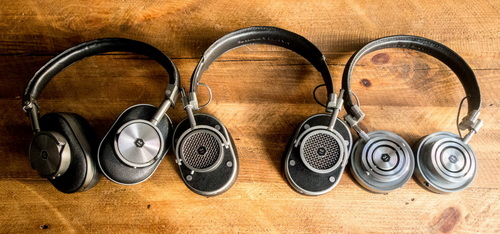
Наушники стали важной частью нашей повседневной жизни, так что порой даже кажется, что ни один человек не может выйти на улицу без пары наушников. Неважно, полноразмерные наушники это или наушники-вкладыши, они являются обязательным аксессуаром современного человека. Но какой была история создания изобретения наушников, когда они впервые появились. Об этом читайте дальше.
Но прежде хотим обратить ваше внимание на то, что если вы ищите хорошие наушники, например беспроводные наушники Маршал, то приобрести такие можно в украинском интернет магазине Stylus.
История наушников уходит корнями в конец XIX века.
Первые наушники
1881 г.
Это самый важный год в истории появления наушников, так как первые наушники были изобретены именно в 1881 году. Но первые наушники были отнюдь не для развлечения, их использовали телефонисты в своей работе. Также они были довольно громоздкими, тяжелыми и неудобными. Так вес таких наушников составлял аж 4,5 килограмма (или 10 фунтов).
1890-е годы
С 1890-х годов до Первой и Второй мировых войн многие женщины работали телефонными операторами. Перед ними были большие коммутаторы и проводные наушники с разъемами, которые должны были подключаться и отключаться от коммутаторов, чтобы управлять и передавать звонки из одного дома/учреждения/офиса в другой. В этих ранних моделях был только один наушник, прикрепленный к очень тонкому оголовью, которое соединялось с микрофоном в виде рупора, располагавшегося на плече оператора.
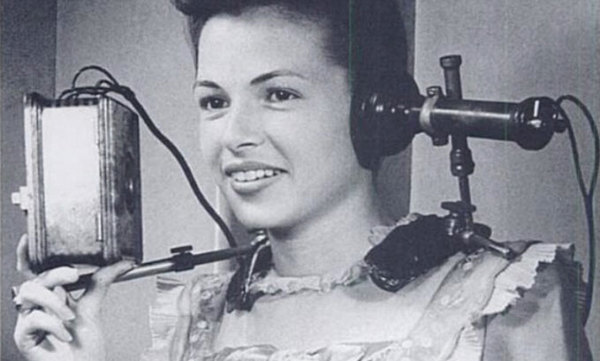
Вот так они выглядели.
1891 г.
После успеха первых наушников французский инженер Эрнест Меркадье изобрел и запатентовал набор наушников-вкладышей, способных самостоятельно держатся на голове. Новые улучшенные наушники пользовались большим успехом благодаря возросшему удобству, а также значительно меньшему весу, что облегчало их использование. Основной причиной снижения веса стала установка миниатюрных приемников. Приемники были адаптированы к человеческому уху, что облегчило вставку, особенно за счет резинового покрытия. Эти наушники можно считать первым предком современных наушников-вкладышей.

Телефонные наушники, запатентованные Меркадье в 1891 году.
Электрофонная система
Несколько лет спустя в Англии была изобретена электрофонная система. Под этим термином мы подразумеваем крестообразную гарнитуру, которая выглядела как комбинация теннисной ракетки и стетоскопа. Наушники, которые должны были быть надеты на оба уха, были соединены ниже подбородка длинной палкой, которую пользователи держали в руках. Когда ручное устройство было отделено от ушей, все вокруг пользователя могли слышать один и тот же аудиоконтент, и это создавало возможность группового прослушивания.
Электрофонная система была создана главным образом для того, чтобы любители оперы могли слушать живые выступления в лондонских театрах, удобно устроившись дома. Система была основана на годовой подписке, которая стоила примерно 5 фунтов стерлингов.

Так выглядела английская электрофонная система.
1910 – 1919 гг.
В индустрии наушников не было крупных изобретений или патентов до первых десятилетий XX века, когда американский изобретатель Натаниель Болдуин изобрел по сути первую модель современных наушников в том виде, который мы знаем сегодня. Натаниель был прихожанином в мормонской церкви и изобретая свои наушники он хотел усилить звук проповедей в мормонском храме.
Наушники Болдуина имели длинный медный провод, подключенный к обеим чашкам, и принимали звук без использования электричества. Чашки были сделаны из латуни, они очень напоминали современные чашки для наушников и даже были соединены двумя элегантными лентами.
Когда ВМС США узнали об изобретении Болдуина, они купили его продукт, чтобы экипировать им моряков и изолировать их от отвлекающих окружающих звуков. После этого наушники Болдуина стали активно использоваться военными.
1937 г.
Следующей вехой в истории наушник стал 1937 год, когда компания Beyerdynamic, выпустила первые на рынке динамические наушники — DT-48. К слову эта модель вполне рабочая и в наше время.
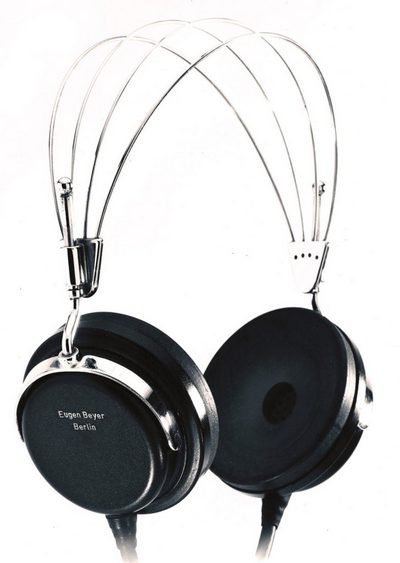
Первые динамические наушники Beyerdynamic DT-48.
Такие наушники, как впрочем, и вообще наушники в те времена, активно использовались в основном военными и в военных целях, для моряков, пилотов. Лишь после окончания второй мировой войны достижения в области наушников начали переходить из военной сферы в гражданскую.

Английский пилоты времен второй мировой, в наушниках.
Наушники во второй половине XX века
1958 г.
1958 год — один из самых важных в истории наушников, поскольку именно в этом году были созданы первые стереонаушники Hi-Fi.
Джазовый музыкант и предприниматель из Милуоки, основатель корпорации Koss, Джон К. Косс задался целью перенести звуковые технологии наушников из военной сферы в гражданскую, чтобы при помощи них можно было не только военные переговоры слушать, но и музыку с хорошим звуком.
Он был полон решимости сделать качественный звук доступным для обычных людей, поэтому он создал «частную систему прослушивания» под названием фонограф Koss Model 390, которая содержала фонограф, динамик и разъемы для наушников в небольшом корпусе. Однако не было коммерческих наушников, которые могли бы работать с его фонографом, потому что все совместимые с ним наушники были сделаны исключительно для военных целей — связи и боевых самолетов. Несмотря на это, Косс был настолько полон решимости осуществить свой план, что заключил сделку со звукоинженером, который помог ему создать прототип наушников, совместимых с фонографом.
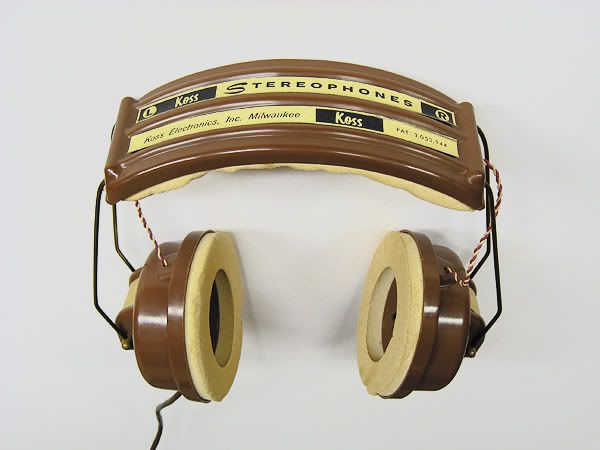
Фонограф Косс 390.
Первая пара представляла собой не что иное, как мини-динамики, покрытые картоном и пеной, но ему удалось их улучшить и создать первые стереонаушники Hi-Fi. Они получили название Koss SP/3 и состояли из двух коричневых пластиковых чашек, 3-дюймовых динамиков, прикрытых легкой пластиковой крышкой, и поролоновых подушек для дополнительного комфорта. Чашки были соединены оголовьем из металла, и в целом внешний вид был очень похож на современные наушники. Наушники стали намного легче, чем раньше. Помимо внешнего вида улучшилось и их звучание, так как в наушниках использовались разные сигналы для каждого уха.
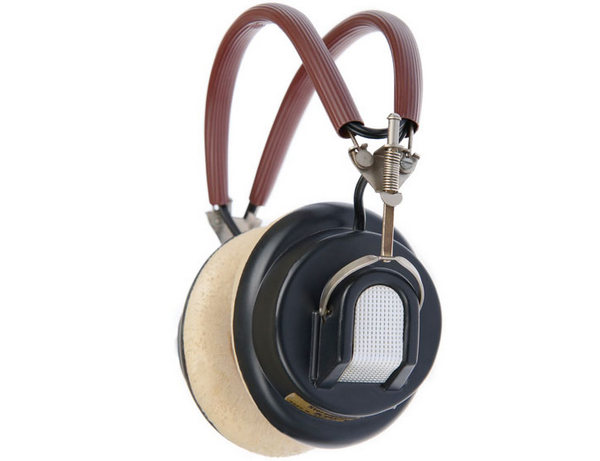
Наушники Koss SP/3.
Впервые наушники были представлены на выставке Hi-Fi в Милуоки в 1958 году и сразу же стали хитом. У них даже был «переключатель конфиденциальности», который позволял прослушивать музыку с звукоизоляцией или без нее.
Первые наушники Koss были основаны на дизайне Болдуина, только с чашками большего размера и улучшенным качеством звука и аудиотехнологиями. Косс сохранил тонкое оголовье Болдуина, но добавил набивку к чашкам для лучшей посадки и комфорта.
По правде говоря, Koss SP/3, вероятно, никогда бы не стал таким популярным, если бы Джон Косс не применил хитрость. Для продвижения своих наушников Косс привлек таких знаменитостей, как Бобби Хакет и Тони Беннетт, но наибольшего успеха он добился, когда заключил сделку со знаменитой рок-группой «Битлз» и выпустил «Битлзфоны». Их выпуск совпал с популяризацией рок-н-ролла, что сделало подростков основной частью поклонников и покупателей Koss.
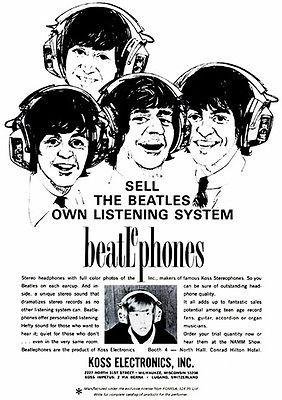
Рекламный плакат Beatlephones.
1966 – 1968 гг.
Этот период также можно считать частью эпохи Косса, потому что все эти годы были отмечены достижениями и инновациями Косса.
В 1966 году Koss выпустила первые наушники среднего класса с подписью знаменитостей — Beatlesphones, которые пользовались огромным успехом благодаря фирменной наклейке Beatles на них.
В 1968 году в США появились первые электростатические наушники Koss. Наушники назывались ESP/6, и их основными характеристиками были малый вес и подавление искажений.
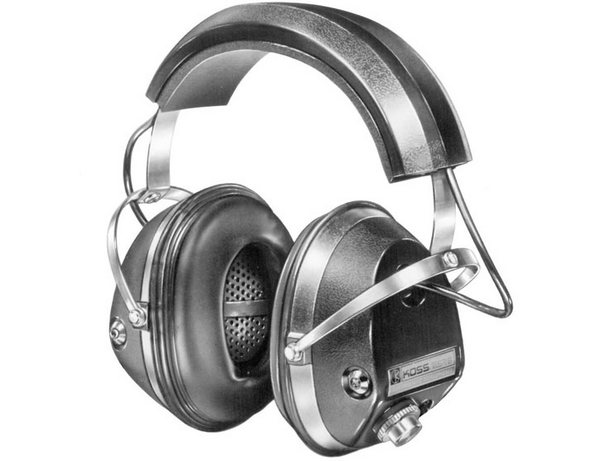
Электростатические наушники Koss ESP/6.
После того, как Koss улучшил качество звука стереонаушников, а также шумоподавление, их главный конкурент Sennheiser решил поработать над дизайном. Им пришла в голову идея немного приоткрыть чашки наушников и впустить немного звука. В результате родились первые наушники открытого типа под названием Sennheiser HD414 с амбушюрами из желтого пеноматериала и неоновой атмосферой прото80-х. Они были легкими, они позволяли человеческим ушам дышать, они пользовались огромным успехом, и к концу того же года, когда они появились, было продано около 100 000 штук. У этой модели Sennheiser был один из самых популярных дизайнов за всю историю, и, поскольку было продано более 10 миллионов единиц, это также одни из самых продаваемых наушников Sennheiser.
Настоящее время
2000-е
Это момент времени, когда начинается экстремальная популяризация наушников. Вместе с тем специалисты разрабатывают новые аудиотехнологии, которые делают различные аудиоустройства доступнее для всех.
2000-е отмечены популяризацией наушников-вкладышей с улучшенной шумоизоляцией и более качественной и плотной посадкой в слуховом проходе. Они также отмечены выпуском продуктовой линейки Bose QuietComfort, которая улучшила технологию шумоподавления и установила некоторые новые стандарты.
2001 г.
Самый важный год в современной эпохе — 2001 год. Это год, когда был выпущен первый iPod. Это карманное устройство, способное хранить более 1000 песен, довело любовь к наушникам до кульминации. iPod был легче, меньше и работал быстрее, чем любое аудиоустройство, но в сочетании с потрясающими наушниками он создавал стильный и престижный гарнитур, которым хотел владеть каждый. Apple использовала тот же трюк, что и Косс, и увеличила популярность iPod, привлекая знаменитостей к продвижению этого интересного устройства. С тех пор Apple является одним из ведущих брендов на рынке и синонимом престижа и качества.
2003 – настоящее время
После успеха, достигнутого Apple с iPod, другие компании решили усерднее работать над их продвижением. Некоторые из них решили улучшить качество звука, но почти все, хотя бы частично, сосредоточились на экспериментах в области дизайна наушников.
В настоящее время ассортимент наушников поистине огромен, с развитием индустрии компьютерных игр появилось множество игровых наушников, с объемным звуком, беспроводные наушники разных форм и размеров, а наушники с встроенным микрофоном незаменимы для всех фрилансеров, работающих удаленно.
Схожі статті:

Сегодня их можно встретить повсеместно: в вагоне метро, у случайного прохожего, в профессиональной студии, на радио и телевидении. Они заполонили нашу жизнь и окрасили ее музыкой самых различных стилей и направлений, сумели сделать звук индивидуальным и неповторимым. Все это заслуга привычных устройств, которые всегда находят место на голове человека, напрямую не связанного с музыкой. Наушники. Тысячи моделей, сотни брендов, десятки типов. Эта статья посвящена истории наушников. От тяжелых и неповоротливых моделей с жутким звучанием, до ультрасовременных беспроводных наушников.
История
Знакомство с любым устройством следует начинать с его истории. Только так можно понять к чему привело развитие технологий и как оно сказалось на качестве конечного продукта, за который вы готовы отдать свои кровные.
В конце XIX века звукозапись начала делать свои первые шаги. О возможности взять с собой десяток-другой песен, нажать клавишу Play и, прибавив на портативном плеере громкости отправиться по делам, тогда никто не задумывался. Мир мыслил иначе, но также жадно и с воодушевлением поглощал новые музыкальные тенденции и делал робкие шаги по развитию технической составляющей музыки.
Тяжелая работа телефонисток в середине XIX века предусматривала постоянное взаимодействие с двумя устройствам: передатчиком и приемником звука. В 1881 году ассистентка телефонной компании Белла Эзра Джиллилэнд предлагает закрепить части телефона к металлическому пруту, зафиксировав 3-килограммовую конструкцию, состоящую из микрофона и динамика, на голове. Это решение, несмотря на свою несуразность и сложность в использовании, положило начало эволюции наушников, а изобретение Джиллилэнд стало первой телефонной гарнитурой.
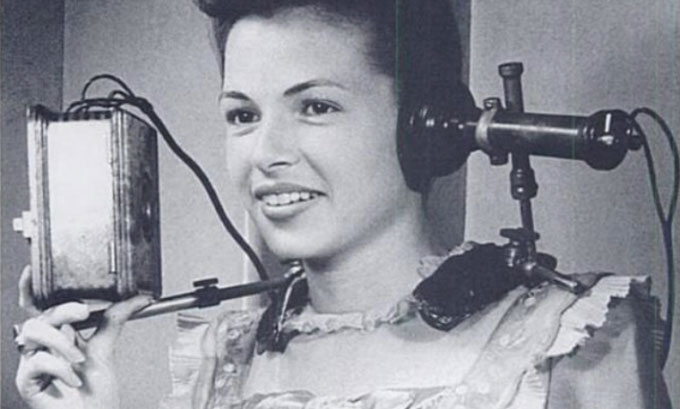
1891 год, французский инженер Эрнест Меркадье патентует набор вставных наушников – прадедушек современных вкладышей. Именно Меркадье можно назвать миниатюристом-Левшой в мире звука. Конструкция наушников, описанных в патентной заявке № 454,138, стала революционной для того времени – миниатюрные наушники-пуговки с резиновым колпачком, уберегающим ушную раковину от раздражения и, вместе с тем, использующимся в качестве шумоподавления.
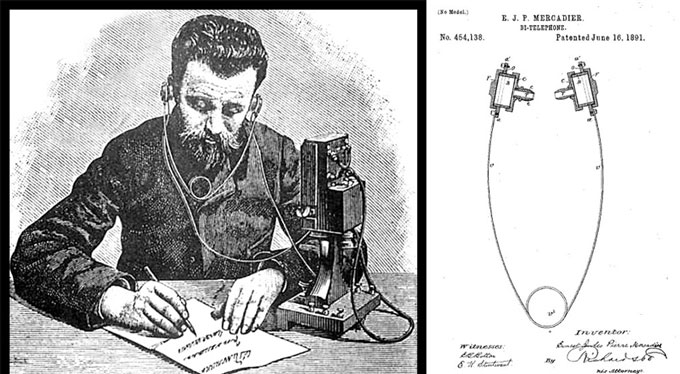
Увы, данная конструкция будет забыта на многие годы, а ближайшие 50 лет индустрией будут править громоздкие головные телефоны.
Еще одна попытка создания прототипа внутриканальных наушников принадлежит известному изобретателю Томасу Эдисону. В 1895 году он патентует устройство, получившее имя «кинетофона». Запатентованный аппарат умел воспроизводить звук и кино одновременно. Его принцип работы основывался на передаче звука от фонографа по полым трубкам прямо в ушной канал. В основе лежал медицинский стетоскоп и никакой электроники.
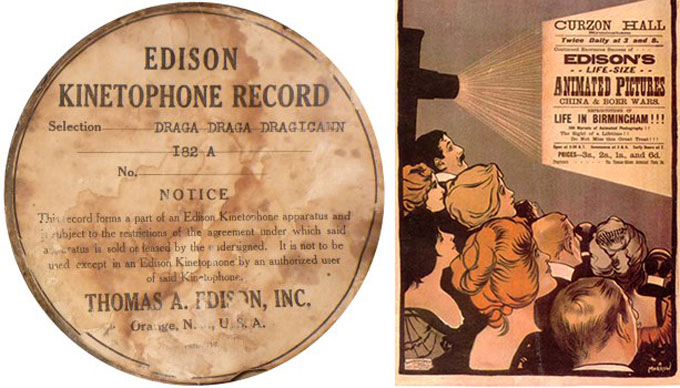
Понимая запросы потребителя, в 1896 году британская компания Electrophone System предложила жителям заманчивый сервис. За 5 фунтов в год подписчик получал возможность удаленного прослушивания прямых трансляций с более, чем 30 церквей и театров, разбросанных по всем уголкам страны.
Необходимое для этого оборудование выглядело в виде небольшого деревянного столика и двух пар наушников с громоздкой ручкой.
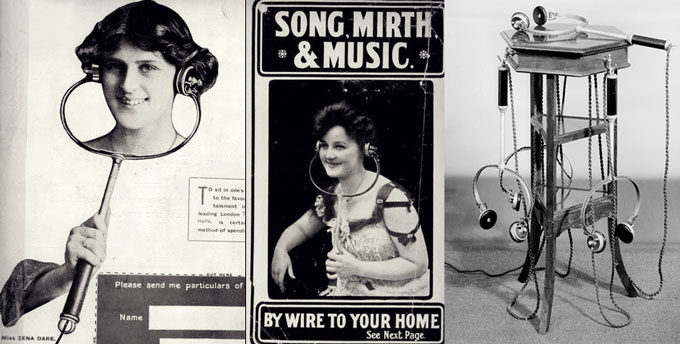
За дополнительный фунт слушатель мог получить еще один комплект «ушей». Сравнить Electrophone System можно с современным сервисами потоковой музыки, вроде Spotify или Deezer, вот только возможности самостоятельного выбора композиций у подписчиков не было. Эту задачу на себя брали телефонистки.

Уже к 1908 году количество подписчиков компании достигло 600 человек. Но вернемся к нашему главному герою – наушникам.
За всю историю развития технологий первая отрасль, куда попадали новейшие изобретения и «технические прорывы» всегда становилась военная промышленность. В 1910 году Натаниель Болдуин предлагает ВВС США несколько чертежей с описанием конструкции головных телефонов. Первая модель наушников, предусматривающая размещение дуги над головой, а не в области шеи. Через несколько лет именно предложенная Болдуином модель, будет главным средством связи для всех операторов военно-морского флота.
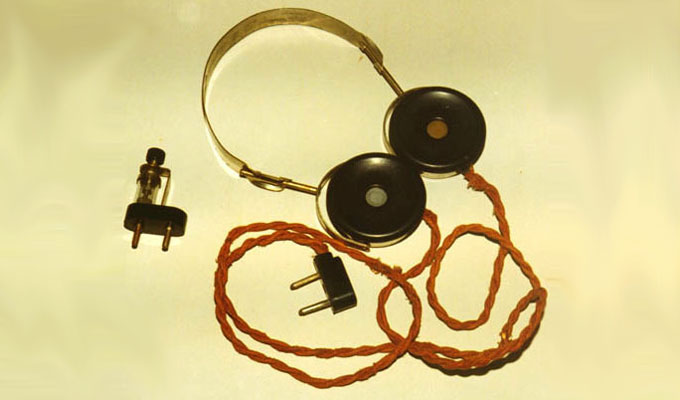
Тяжеловесная конструкция наушников претерпела еще несколько изменений, оголовье получило обтяжку из кожи и регулировку размера. Усовершенствование конструкции наушников принесло Болдуину звание отца всех современных наушников.
В 1921 году на рынок США выходит серийная модель радиоприемника Western Electric. В комплекте с устройством покупатель получал высокоомные наушники CW-834.
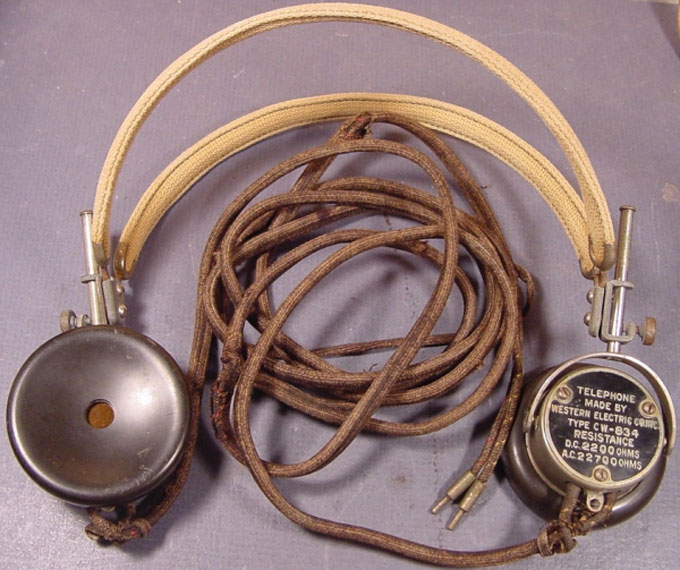
Тридцатые годы XX века. Наушники повсеместно используются для связи, они заполоняют дома жителей крупных городов. Популярные развлекательные передачи по радио предпочитают слушать именно в наушниках. Вместе с этим, их конструкция и технические характеристики были далеки от совершенства. Прослушивание музыки в наушниках было похоже скорее на самоистязание – они прекрасно справлялись с речью, но с музыкой дела обстояли совсем плачевно. Кардинально изменить ситуацию решил 18-летний Ойген Байер, выходец из Швеции, взявший на себя роль революционера аудиотехники.
В 1926 году Байер основывает фирму с громоздким названием Elektotechnische Fabrik Eugen Beyer. Приоритетным продуктом компании долго оставались микрофоны, но в 1937 году Байер все же решается на выпуск наушников.
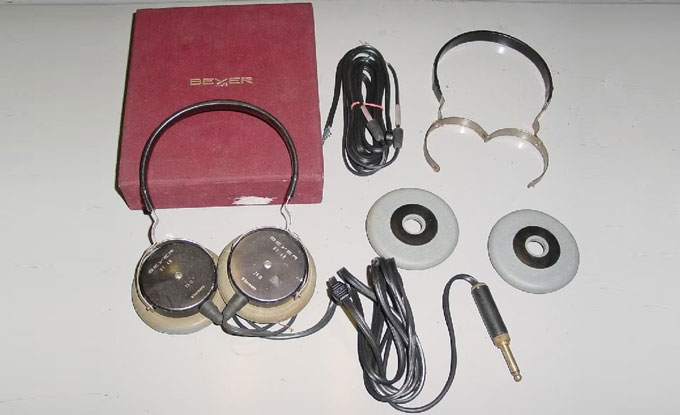
Первая модель динамических наушников компании Beyerdynamic DT-48. Сегодня именно наушники такого типа являются самыми доступными и распространенными. Легендарная модель наушников Beyerdynamic DT-49 выйдет спустя 16 лет – в 1953 году. Они были рассчитаны на массового покупателя в первую очередь благодаря своей дешевизне.
Но компания, которая действительно смогла встряхнуть мир и выпустить наушники «для всех и каждого», изначально занималась прокатом телевизоров. В 1958 году Джон Косс представляет на выставке потребительской электроники портативный виниловый плеер. По сути, устройство представляло собой традиционную вертушку, установленную в чемодан. В комплекте с плеером поставлялись и наушники, для изготовления которых Джон Косс и Мартин Ланге воспользовались моделью стандартных авиационных головных телефонов. Вооружившись деталями от старого телевизора, изобретатели сумели преобразить качество звука.
Сам проигрыватель особо никого не заинтересовал, а вот звучание наушников сумело поразить всех, присутствовавших на выставке посетителей. Сообразив, что за наушниками большое будущее, Джон Косс выпускает первую серийную модель Koss SP-3.
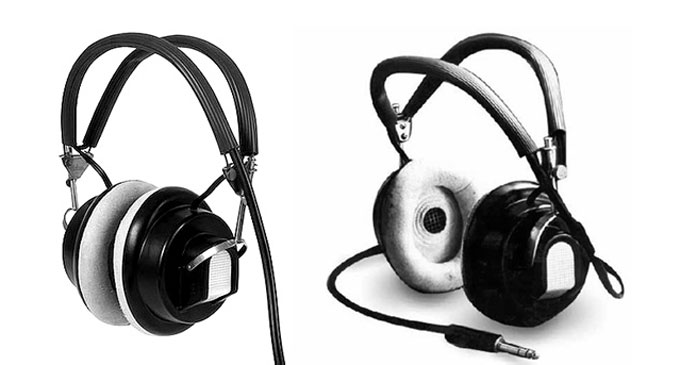
Именно модель Koss SP-3 стала прототипом современных внутриканальных наушников. Направление звука в SP-3 осуществлялось не в ушную раковину, а в ушной канал. Успех первой серийной модели наушников компании Koss сделал ее практически монополистом на рынке. К 1967 году оборот компании превысил $1 млн. Позднее, в 1983 году, на рынок выйдет еще одна легендарная модель Koss Porta Pro.
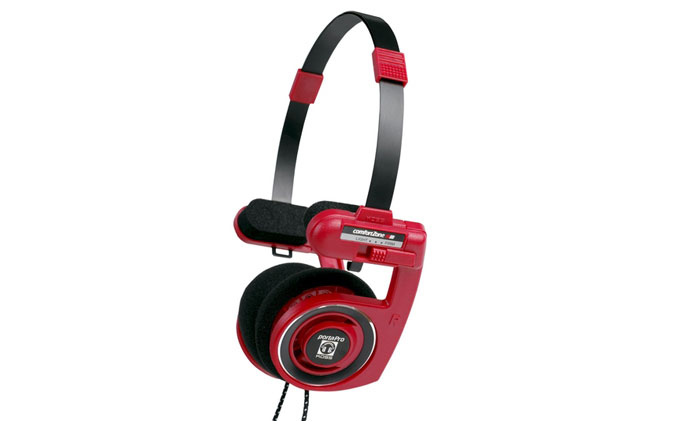
За 13 лет продажи SP-3 значительно упали, а конкуренты в лице Beyerdynamic и Sennheiser свою долю рыночного пирога уступать не думали. Именно модель наушников Koss Porta Pro сумела вновь вывести компанию из затянувшейся финансовой депрессии. Доступная цена, выделяющийся из толпы дизайн и главное – хорошее качество звучания сделали очередную революцию в мире портативного звука, а поклонники компании Koss спустя 35 лет отдают предпочтение олдскульным Porta Pro.
Категорию наушников электростатического типа впервые представила японская компания Stax в 1959 году. Наушники Stax невозможно купить в обычном магазине бытовой техники, ими никогда не комплектуются портативные плееры. Эти наушники изначально были созданы для узкой аудитории профессионалов.
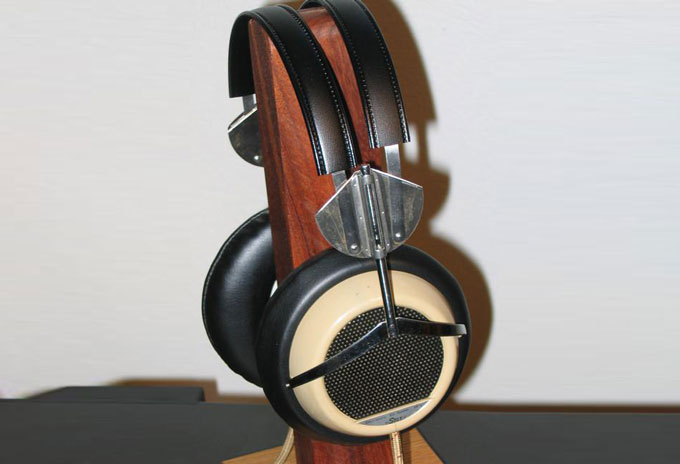
Использование сверхтонкой мембраны, размещенной между двумя электродами и усилитель высокого напряжения вызывают звуковые колебания при минимальном уровне гармонических искажений и завидной чувствительности. Из-за высокой цены массовый рынок не готов к такой модели и сегодня, хотя звучание электростатических наушников близко к эталоному.
Свой ответ компании Stax позднее даст и компания Koss, выпустив модель эдектростатических наушников Koss ESP-6.
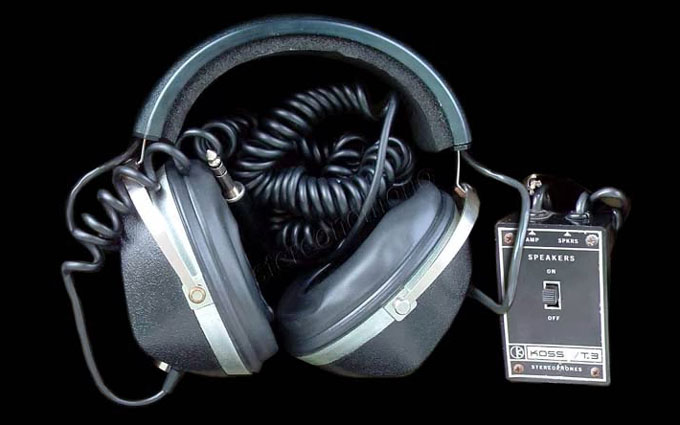
Вес в 900 грамм и немалая цена не позволили модели прижиться на рынке и в скором времени ее сняли с производства.
В 1964 компания Beyerdynamic выпускает вставной наушник DT 507, вес которого составляет всего 11 грамм. Он поставлялся в комплекте с фирменным радиоприемником. Год спустя в СССР появится «самый маленький радиоприемник», двухдиапазонный «Микро», размер которого не превышал спичечный коробок.
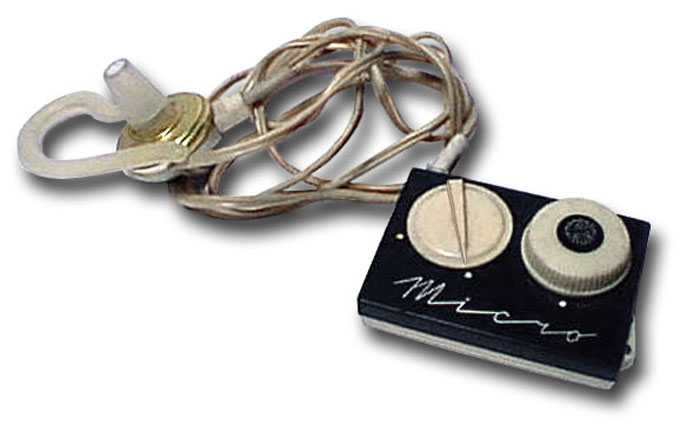
«Микро» комплектовался миниатюрным моно-наушником TM-2M с несколькими резиновыми насадками и гибкой заушиной.
Вплоть до 1968 года весь ассортимент наушников был представлен исключительно моделями закрытого типа. Слышать музыку мог только один человек, а весь звук оставался в «раковине» наушника. Закрытый с обратной стороны уха драйвер не только полностью изолировал музыку, но и делал наушники тяжелыми и громоздкими. Существенно облегчить конструкцию и открыть драйвер решилась немецкая компания Sennheiser, судьба которой пересекается с Beyerdynamic: вплоть до 1960 года Sennheiser занималась исключительно производством микрофонов.
Первыми наушниками с открытой конструкцией стала модель Sennheiser HD 414.

Sennhеizer HD 414 взорвали рынок. Количество проданных наушников превысило 10 миллионов, а слава производителя молниеносно облетела весь мир. Получив патент на наушники открытого типа в далеких 60-х, компания Sennheiser продолжает получать пожизненные отчисление с каждого бренда, выпускающего такой тип наушников.
Поддержать истерию вокруг массового использования наушников сумела и компания Sony. В 1979 году на рынок выходит первый портативный плеер Walkman. Его главным партнером становятся наушники Sony MDL-3L2: легкие, удобные и недорогие.
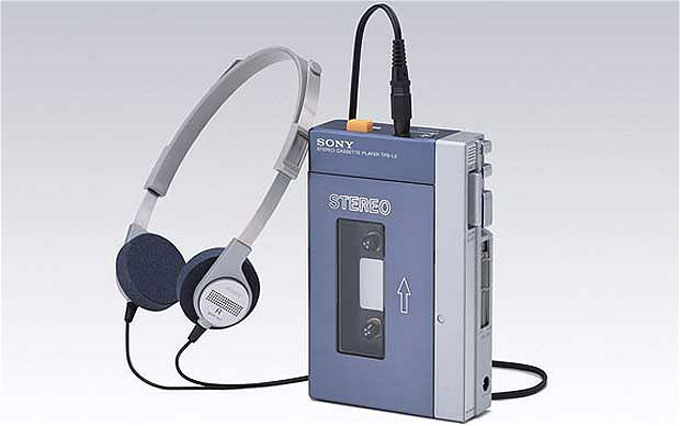
Дальнейшая история наушников имеет целый ряд ответвлений, появлением новых категорий устройств, основанных на старых принципах. Использование в авиации системы шумоподавление не могло не повлиять и на сферу наушников для рядового потребителям. Начиная с 1986 года, компания Bose стала одним из крупнейших поставщиков наушников с системой активного шумоподавления для пилотов. На массовый же рынок запатентованная компанией система QuietComfort, используемая в наушниках, добралась лишь в 2000 году.
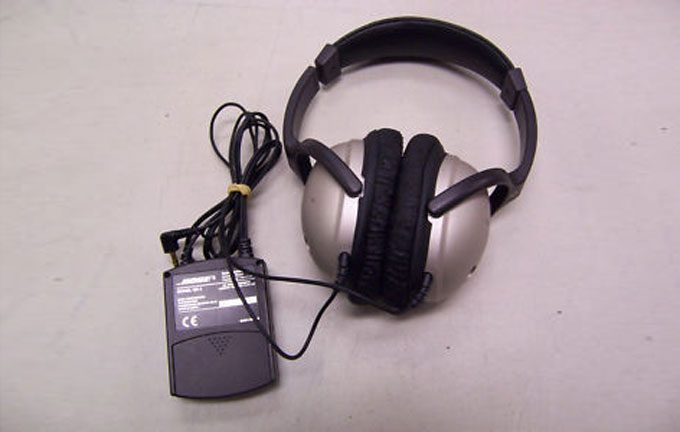
Появление первых беспроводных наушников можно отнести еще к началу девяностых, когда компания Koss анонсировала модель, позволяющую при помощи инфракрасного луча подключаться к усилителю или источнику звука при помощи идущей в комплекте приставки.
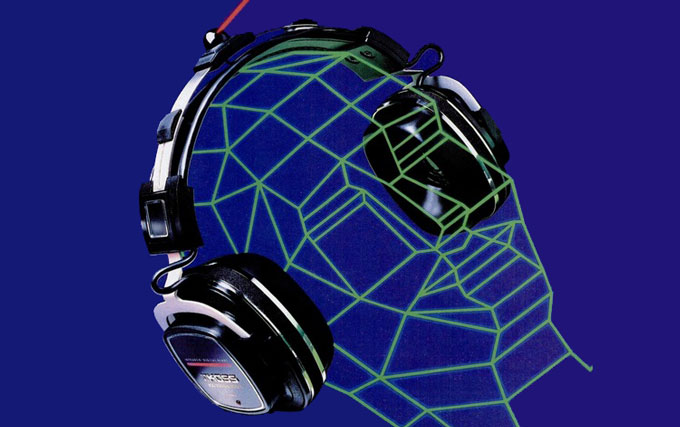
Идею беспроводных наушников тут же подхватила и компания Recoton, представив модель наушников, работающих на частоте в 900 МГЦ и имеющих радиус действия вплоть до 45 метров.
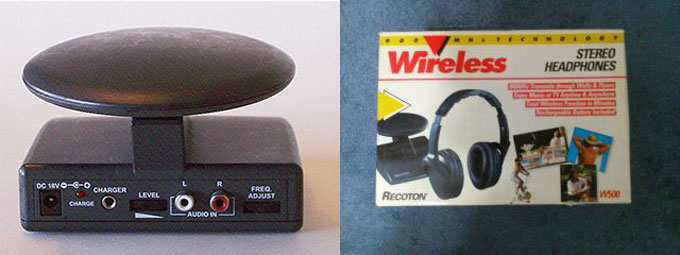
В 1997 году Recoton получило отказ от правительства Великобритании на производство беспроводных наушников, работающих на частоте в 900 МГЦ, в связи с тем, что данная длина волны уже используется. В поисках комфорта и альтернативной технологии отказа от проводов в 1998 году перед производителями открываются новые возможности трансляции «звука без проводов» – Bluetooth.
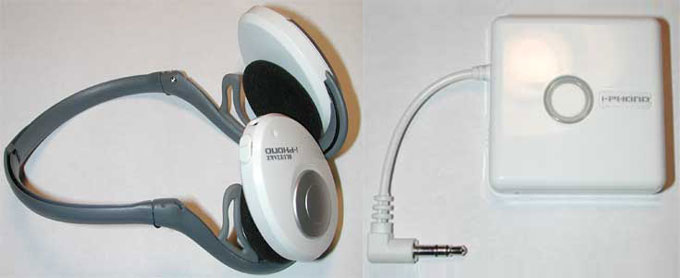
Шесть лет развития технологий и в 2004 году на рынок выходят первые беспроводные наушники Bluetake i-PHONO BT420EX с собственным передатчиком (в 2004 году рынок не заполнен достаточным количеством мобильных Bluetooth-устройств. Спустя год на рынке начнут появляться первые наушники, использующие для передачи звука беспроводную сеть Wi-Fi.
Сегодня производители продолжат творить историю, создавая новые неординарные решения к осознанию того, как именно должны выглядеть наушники. Такая гонка брендов нередко приводит к тому, что конечный покупатель обращает внимание в первую очередь не на качество звучания конкретной модели, а на их дизайн. Но ведь вся долгая эволюция развития портативной музыки и наушников начиналась с желания инженеров улучшить звук и сделать возможным прослушивание не только речи, но и музыки. Такое желание привело к появлению сложной иерархии видов и категорий наушников, с которыми познакомимся во второй части статьи.
P.S.: Спасибо нашим друзьям из Bowers & Wilkins за информацию, историю и интересные факты о наушниках.




 (7 голосов, общий рейтинг: 4.86 из 5)
(7 голосов, общий рейтинг: 4.86 из 5)
🤓 Хочешь больше? Подпишись на наш Telegram.

iPhones.ru
Сегодня их можно встретить повсеместно: в вагоне метро, у случайного прохожего, в профессиональной студии, на радио и телевидении. Они заполонили нашу жизнь и окрасили ее музыкой самых различных стилей и направлений, сумели сделать звук индивидуальным и неповторимым. Все это заслуга привычных устройств, которые всегда находят место на голове человека, напрямую не связанного с музыкой. Наушники….
- наушники и колонки,
- ретроспектива
![]()
Содержание
- Кто и в каком году придумал первые в мире наушники
- В каком году изобрели первые наушники
- Кто изобрёл первые наушники
- Кто придумал первые в мире Bluetooth-наушники
- Как эволюционировали наушники
- Вывод
- Беспроводные наушники: 10 лет прогресса
- Борьба за качество
- Жизнь без розетки
- Беспроводные наушники история создания
- Знаете ли вы, какие TWS-наушники были первыми? Вы удивитесь, но это не AirPods
Кто и в каком году придумал первые в мире наушники
Сейчас наушники есть у каждого второго. У них разная форма, типы конструкций, виды. Однако первые модели отдаленно напоминали нынешние устройства и скорее выглядели как телефонные аппараты. Разбираем с тем, кто и когда придумал наушники, а также как они эволюционировали.
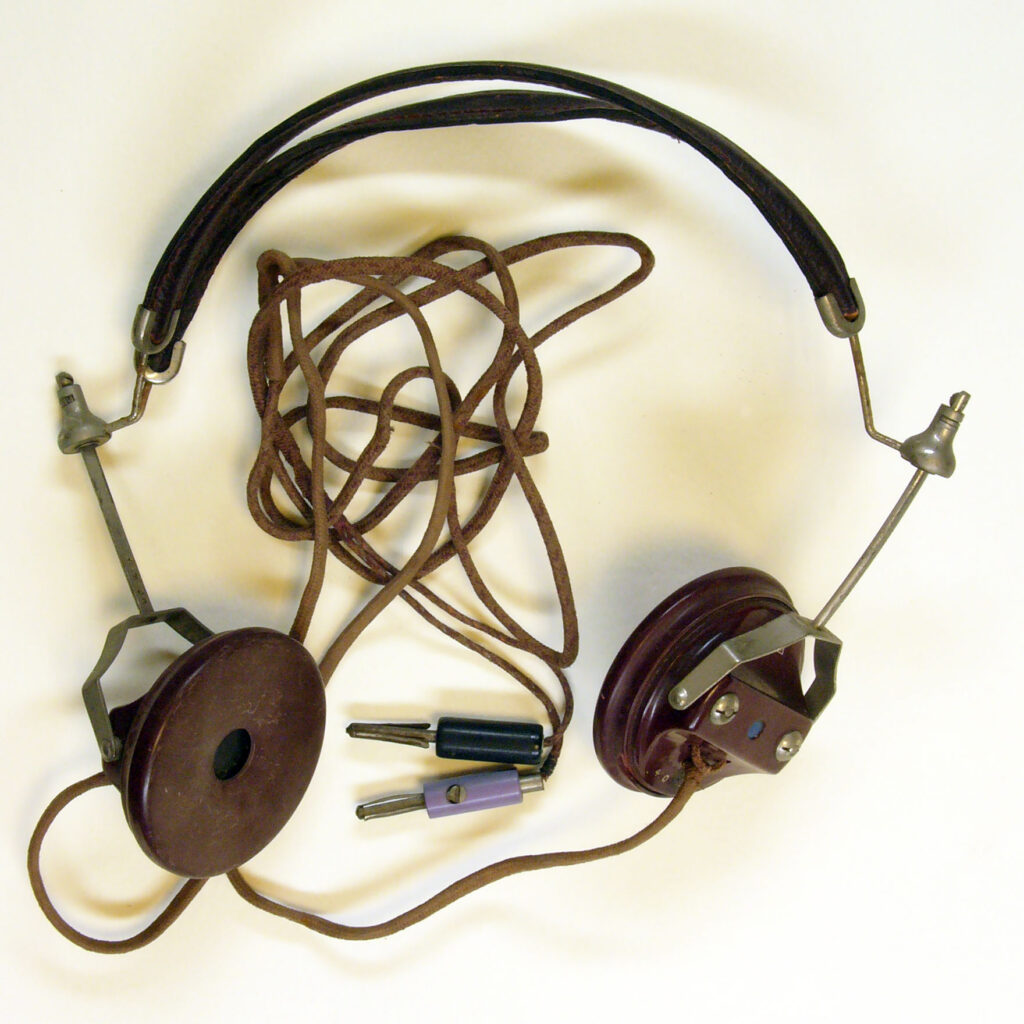
В каком году изобрели первые наушники
Первые наушники, а вернее их прототип, появились в 1881 году благодаря телефонистке Белле. Дело в том, что труд телефонисток был сложен, т.к. им приходилось одновременно взаимодействовать с приемником и передатчиком во время разговоров, то есть телефоны они постоянно держали в руках. Тогда Белла придумала конструкцию с металлической дугой, на которой устанавливались части телефонного устройства. Предшественник современной гарнитуры был неудобен, т.к. весил под 3 килограмма. Однако в руках больше ничего не нужно было держать, что упростило работу для телефонисток и дало толчок в совершенствовании прибора и создании полноценных моделей.
Кто изобрёл первые наушники
Хотя история возникновения наушников более глубокая, их создателем принято считать американца Натаниэля Болдуина. В 1910 году он составил и продал в ВВС США чертежи наушников. Натаниэль не изобрел первые наушники в прямом смысле этого выражения. Но он доработал их конструкцию. Его устройство оснащалось дугой, проходящей над затылком, а длина ее регулировалась. Дуга удерживала «уши», что полностью освобождало руки оператора. Инженер улучшил также и характеристики излучателей, увеличив их чувствительность в 2 раза в сравнении с теми с предшественником.
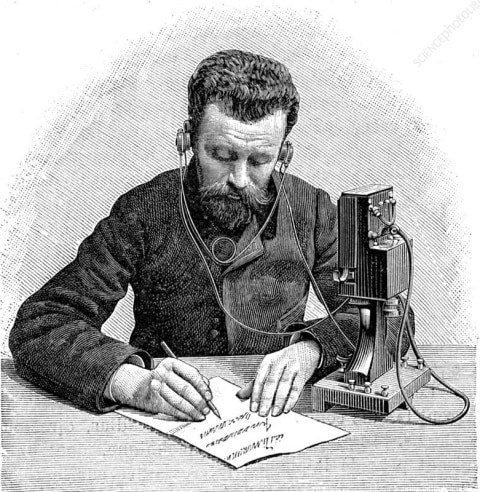
Впоследствии американские военные пригласили в лабораторию инженеров, которые начали работу над развитием трудов американского изобретателя.
Кто придумал первые в мире Bluetooth-наушники
Первые беспроводные наушники появились в начале 90-х прошлого века, когда бренд Koss представил модель, способную подключаться к усилителю или источнику звука посредством с помощью ИК-луча. Эту идею быстро подхватили мировые производители. Немногим позже фирма Recoton произвела устройства, функционирующие при частоте 900 МГц и с радиусом действия до 45 м.
Однако в 1997 году фирма получила отказ от британского правительства на производство данной модели, т.к. такая же частота уже использовалась. В поисках альтернативы в 1998 году Recoton увидела новую возможность в развитии беспроводных аксессуаров – блютуз. Первая модель, базирующаяся на этой технологии, поступила в продажи в 2004 году.
Далее наушники постепенно эволюционировали, становясь меньше и комфортней. А в конце 2016 года Apple выпустила беспроводные AirPods, тем самым дав толчок моде на TWS-наушники. Хотя впервые такие устройства появились в 2014 году в модели Bragi Dash.
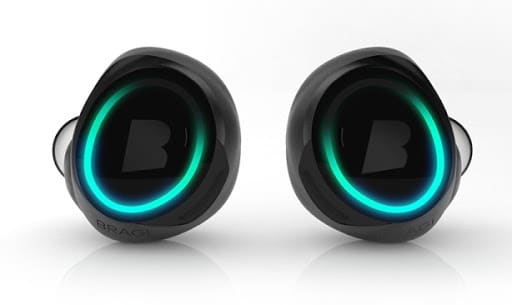
Наушники Bragi Dash
Как эволюционировали наушники
Раньше человек и не задумывался о том, что через наушники (headphones) можно слушать музыку, например, прогуливаясь по городу или по дороге на работу. Тогда это были массивные устройства, предназначенные для связи. Кратко о том, какую эволюцию они прошли:
В 19 веке телефонистки во время работы взаимодействовали одновременно с передатчиком и приемником, что нагружало их руки. В 1881 году телефонистка Белла Джиллилэнд закрепила микрофон с динамиком на голове. Все это крепилось на конструкцию весом от 3 килограммов.

Десять лет спустя Эрнест Меркадье, французский инженер, патентует вставные аксессуары. На тот момент такая конструкция была революционной, т.к. она представляла собой маленькие устройства с наконечниками из резины для минимального воздействия на слух и шумоподавления. Однако мир этого не принял, и в последующие 50 лет наушники имели вид, предложенный Беллой Джиллилэнд.
 Первые вставные наушники
Первые вставные наушники
В 1895 году изобретатель Томас Эдисон работает над внутриканальными приборами и создает некое устройство, получившее название кинетофон. Прибор воспроизводил картинку и звуки. При этом звук проходил через трубки, которые помещались в уши слушателям.
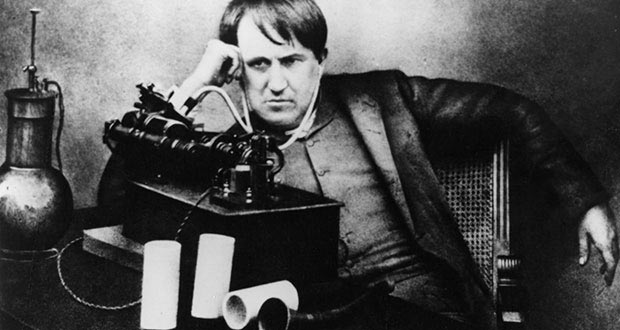
Кинетофон и Томас Эдисон
Следующий этап в эволюции наушников сделали британские инженеры. В 1896 году Electrophone System разработала для жителей необычный сервис. За 5 фунтов человек мог слушать прямые трансляции из театров и церквей, расположенных в разных точках мира. Оборудование для воспроизведения напоминало деревянный столик – на нем лежала пара «ушей» с длинной ручкой, которая и держала аксессуар.

В 1910 году Натаниэль Болдуин американской ВВС чертежи с головными телефонами. Он создал первые наушники, в которых дуга закреплена на затылке, а не в области шеи. Спустя несколько лет модель, предложенная Натаниэлем, попала на вооружение операторов ВВС США. Далее гаджеты тестировались и совершенствовались – их уменьшали и делали легче, обтягивали кожей, а также разработали регулятор размеров дуги.

Операторы ВВС США в первых наушниках
К началу 1930-х годов эти устройства использовались для связи и уже были у большинства жителей городов. Люди слушали передачи по радио в наушников, хотя их конструкция все еще была далека недоработанной. Голос через устройство передавался неплохо, а вот качественно воспроизводить музыку они так и не научились. Исправить ситуацию взялся Ойген Байер, выходец из Швеции. Он основал фирму, выпускающую микрофоны, а к 1938 году начал выпускать наушники. Первой стала динамическая модель Beyerdynamic DT-48. Следующая версия (DT-49) была выпущена более чем через 15 лет.
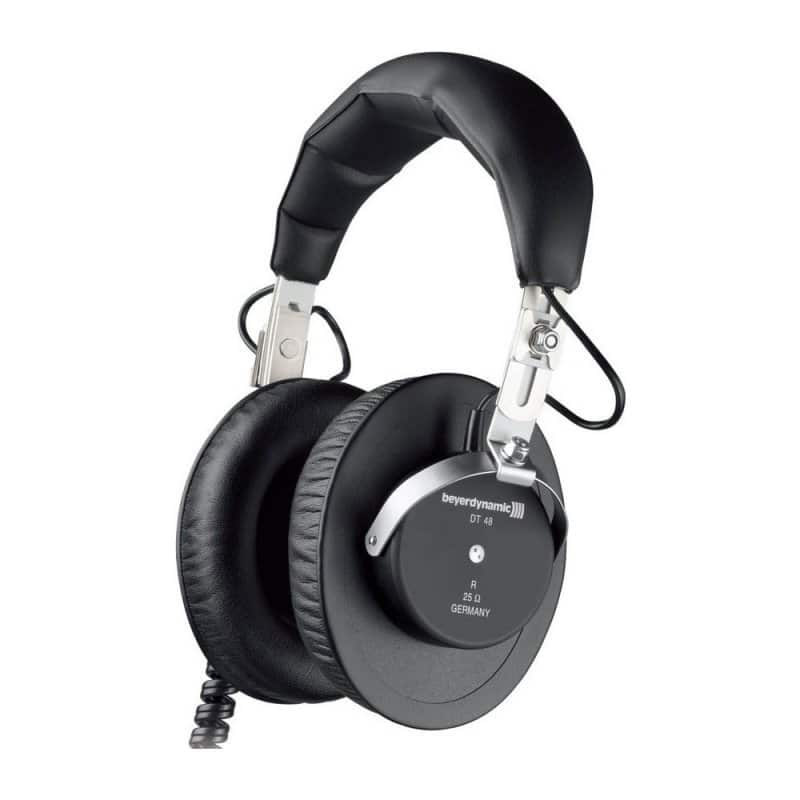
Но первым, кому удалось выпустить массовую модель, стал Джон Косс. В 1958 году его компания представила на выставке портативный плеер для воспроизведения винила. Конструктивно это была некая вертушка, заключенная в чемодан. В коробке с плеером шли и «уши», для изобретения которых Косс вместе с Мартином Ланге взяли в основу авиационные телефоны.
 Портативный виниловый плеер KOSS
Портативный виниловый плеер KOSS
Появление самого плеера никого на выставке не удивило, а вот звук наушников поразил многих. После Косс сообразил, что за этими устройствами лежит будущее, поэтому он выпустил серийную модель Koss SP-3. Это прототип внутриканальных моделей. В SP-3 звук в ушной канал. Это улучшило качество звучание и шумоподавление. В Дальнейшем фирма Косса стала монопольной, а ее оборот превысил к 1967 году $1 млн.
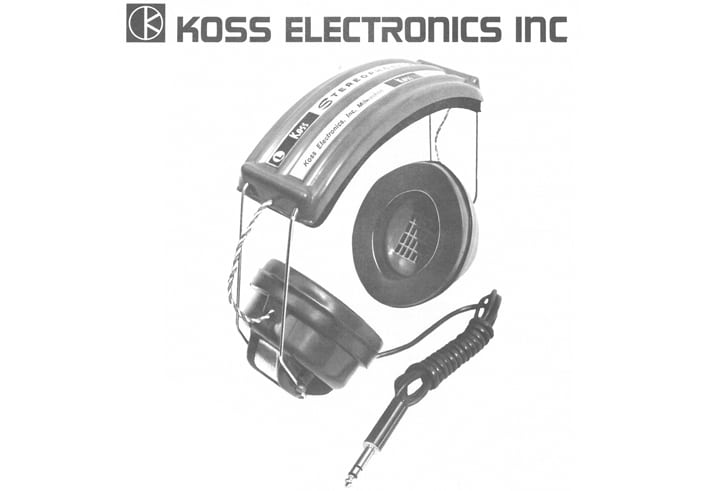
После успеха Джона Косса эволюция наушников достигло своего пика. В 1964 году Beyrdynamic выпустило устройство, которое весило 11 граммов. В коробке также шел компактный радиоприемник для прослушивания. Через год в СССР вышел портативный радиоприемник «Микро», оснащенный моно-наушником, и сразу же набрал популярность в Москве.
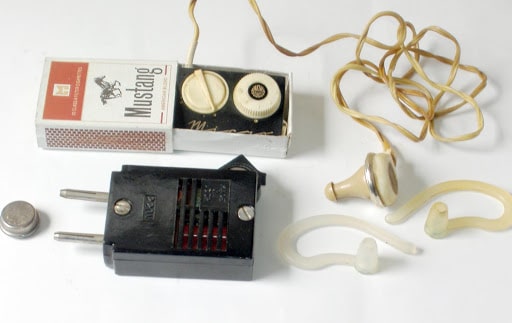
До 1968 года эти аксессуары представлены были только устройствами закрытого типа, пока компания Sennheizer не выпустила первые в мире открытые наушники – Sennheizer HD 414. Количество их продаж превысило 10 миллионов экземпляров. Интересный факт: установив патент на производство открытых наушников еще в 60-х, Sennheizer до сих получает отчисления от каждой фирмы, выпускающей гаджеты такой конструкции.
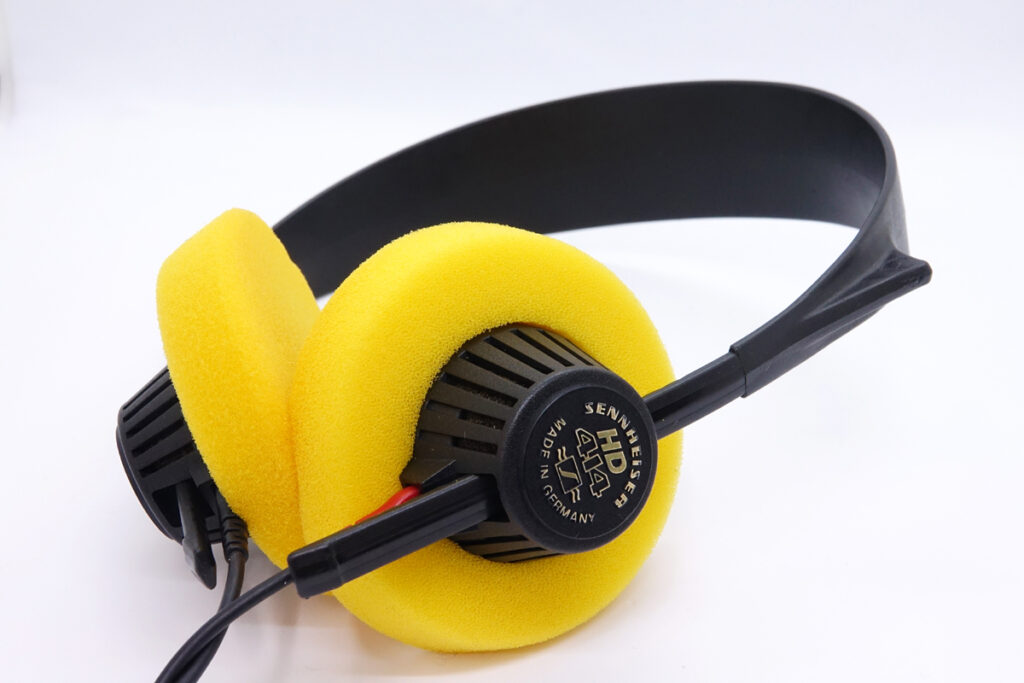 Sennheizer HD 414
Sennheizer HD 414
В 1979 году японская Sony выпустила 1-й портативный плеер Walkman, который комплектовался наушниками Sony MDL-3L2. Они были легкими и доступными, поэтому позволить их могли многие. По виду и конструкции они напоминали привычные человеку гарнитуры.
К 90-м годам прошлого века произошло создание прототипов беспроводных моделей. А в 1998 для подключения стала использоваться технология Bluetooth.
Вывод
Со времени создания первых прототипов наушников прошло более 100 лет. С тех пор эти аксессуары сильно эволюционировали. Кроме накладных моделей появились вкладыши с активным шумоподавлением, затычки (капельки) и даже устройства костного типа. С фото и дополнительной информацией ознакомиться можно в википедии.
Источник
Беспроводные наушники: 10 лет прогресса
Отвязать наушники от устройства, на котором хранятся аудиофайлы, производители пытаются уже лет сорок — Sennheiser, например, уже в середине семидесятых реализовала передачу по ИК-каналу и в 1975 году выпустила инфракрасные передатчик и наушники-стетоскоп. В 1993 году появились и беспроводные цифровые ИК-наушники, но мировую популярность не завоевали в силу ограничений, которые накладывает сама природа передачи по ИК-каналу. Главное из этих ограничений — малое максимальное расстояние между устройствами и необходимость стабилизировать их относительно друг друга.
Появившийся в 1998 году стандарт Bluetooth решил врожденные проблемы ИК-портов, но беспроводная аудиотехника на его основе появилась не сразу: Bluetooth 1.0 и несколько его первых итераций, во-первых, не позволяли передавать достаточно быстро, а во-вторых, имели проблемы с совместимостью проигрывателей с наушниками. Бал тогда правили айподы, но компания Apple не считала нужным добавлять в конструкцию Bluetooth-модули, поэтому интернет тех лет пестрил статьями о том, как, вооружившись паяльником и дрелью, сделать iPod беспроводным. Стоит ли говорить, что даже самая удачная из таких поделок не могла дать ни хорошего качества звука, ни других преимуществ беспроводной аудиотехники.
Борьба за качество
Выпущенная в 2007 году версия Bluetooth 2.0 отлично справлялась с передачей музыки от устройства к устройству без задержек, Bluetooth-чип стали добавлять в смартфоны по умолчанию, и рынок беспроводных наушников начал стремительно развиваться — но долго оставался нишевым: беспроводными наушниками пользовались в основном для занятий спортом. Люди, требовательные к качеству звука, не пользовались ими: потери качества из-за сжатия были ощутимыми. Понадобилось больше десяти лет работы над алгоритмами компрессии, кодировками и технологиями передачи данных, чтобы производители смогли поставить беспроводные системы в один ряд с аудиофильской техникой.



Большим шагом в выравнивании качества звука у проводных и беспроводных устройств стало появление в 2016 году протокола aptX HD; разработанный на основе используемого с 80-х aptX, он позволил ускорить передачу данных по радиоканалу (до внушительных 576 кбит/с) с обычным коэффициентом компрессии (4:1), но в настоящем CD-качестве — до 24 бит/48 кГц.
Стереотип о том, что передача по Bluetooth «съедает» качества звука, продолжает существовать в среде любителей Hi-Fi аудио, и производители выкатывают альтернативные технологии беспроводной передачи данных. Самой успешной премьерой последних лет стала технология Kleer, обеспечивающая передачу несжатого сигнала CD-качества в разы быстрее Bluetooth; файл MP3 от передачи через Kleer не теряет в качестве даже с максимально возможным на сегодня битрейтом — 320 кбит/с, и даже аудиофильские форматы вроде FLAC звучат так, как будто пришли по качественному медному проводу. Sennheiser реализует Kleer в своих наушниках уже несколько лет, и успешно: первой стала беспроводная стереосистема (наушники-вкладыши + Kleer-передатчик) MX W1 от Sennheiser. Благодаря этой же технологии малышки-вкладыши Momentum True Wireless звучат не хуже огромных проводных студийных «ушей».
Жизнь без розетки
Десять лет с лишним рыночного отбора пережили три варианта беспроводных наушников: большие и мягкие накладные — для прогулок, путешествий и работы; «истинно беспроводные» вкладыши, по одному в каждое ухо, и связанные гибким кабелем вкладыши, которые до сих пор пользуются популярностью у спортсменов и людей, которые очень боятся потерять «истинно беспроводные».
Источник
Беспроводные наушники история создания
Будь в курсе последних новостей из мира гаджетов и технологий

Знаете ли вы, какие TWS-наушники были первыми? Вы удивитесь, но это не AirPods

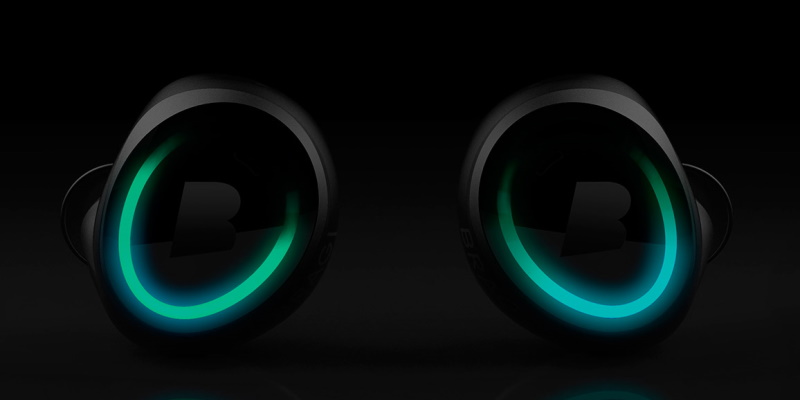
По-настоящему беспроводные наушники (они же TWS-наушники) безумно популярны. Но знаете ли вы, какая модель была самой первой и задала тренд в этом направлении? Нет, это не AirPods от Apple, хотя именно эти наушники воспринимаются многими как эталон.
Первыми TWS-наушниками можно считать Dash от немецкой компании Bragi. Они были представлены на Kickstarter в феврале 2014 года, а поставки первым покупателям намечались на январь 2015 года по цене 199 долларов (около 14,5 тысяч рублей по нынешнему курсу). Стартап сдержал своё обещание, но выпустил продукт позже запланированного — в декабре 2015 года. На Kickstarter эти наушники привлекли более 3,39 миллиона долларов США почти от 16 тысяч покупателей. Модель продаётся и сейчас, но уже дороже (например, в России более чем за 30 тысяч рублей).

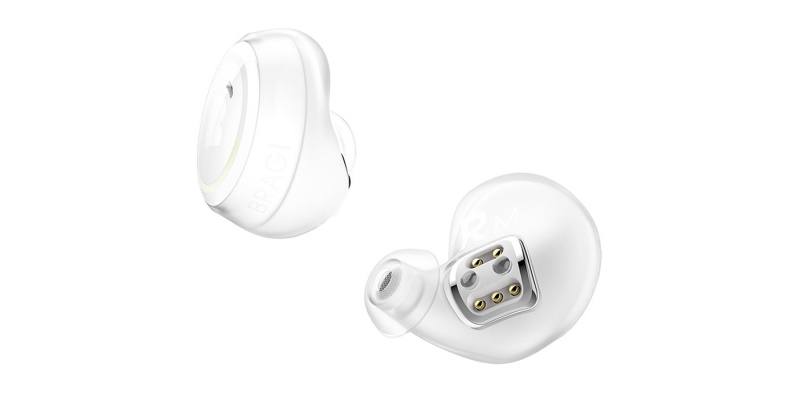
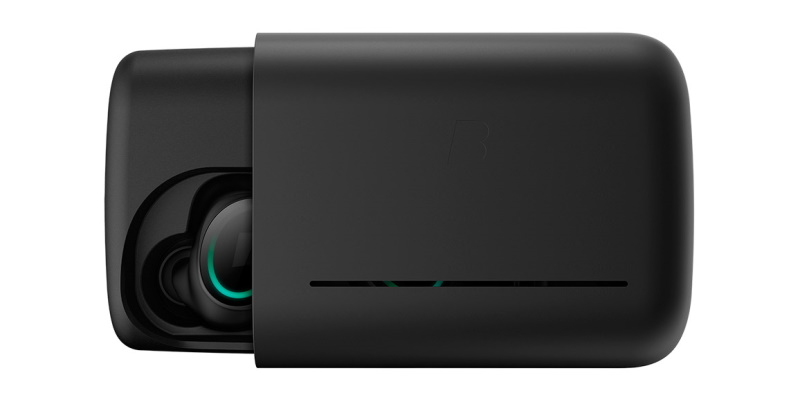
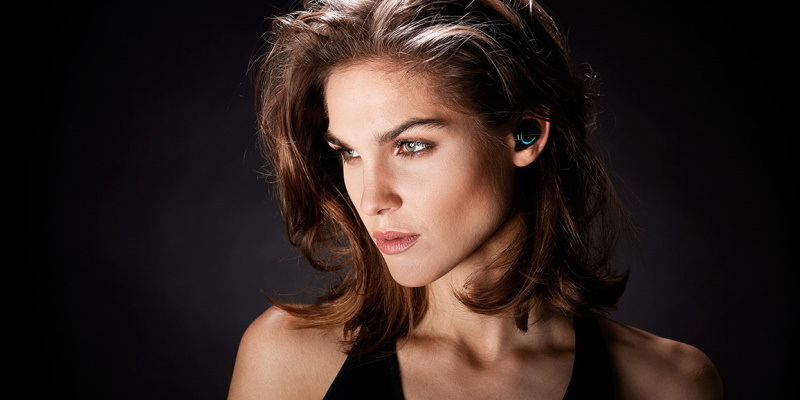
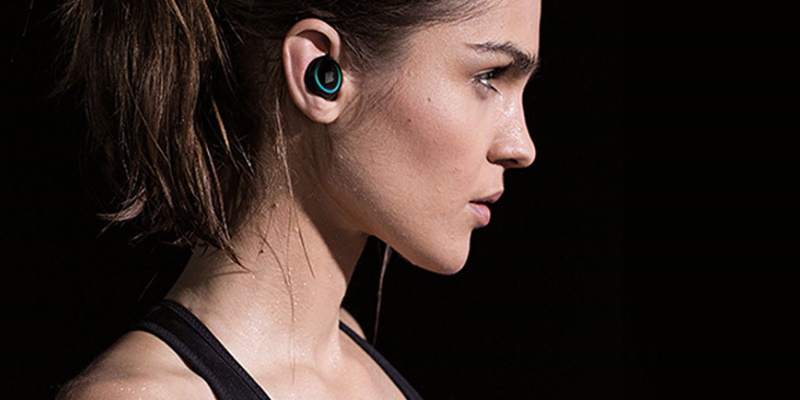

Компания Bragi была основана в 2013 году Николаем Хвиидом, который до этого работал главой команды дизайнеров в Harman. В разработке модели Dash также принимал участие Йозеф Шайдер, бывший глава механического дизайна AKG.
Наушники Dash вполне продвинутые даже по современным меркам. В них установлен 32-битный ARM-процессор, звуковой чип с поддержкой Bluetooth 4.0, кодека aptX и 22-битной обработки сигнала, трёхосный акселерометр, термометр, пульсометр, микрофоны и динамики мощностью по 10 мВт, а также накопитель 4 ГБ. Наушники заряжаются менее чем за час и работают до 4 часов в режиме воспроизведения музыки, до 7 часов в режиме фитнес-трекера и до 3 часов в смешанном режиме (музыка и трекер). От зарядного кейса их можно подзарядить пять раз. Предусмотрена защита от влаги, причём наушники выдерживают даже погружение в воду.
Использовать Dash можно как вместе со смартфоном или планшетом, так и полностью автономно, заранее загрузив музыку в накопитель. Наушники работают как фитнес-трекер, датчик показателей здоровья и подхватывают геолокационную информацию от смартфона. С их помощью также можно находить сопряжённое устройство — отправляя ему команду, чтобы оно издавало звуковой сигнал.
Активного шумоподавления у Dash нет, только пассивное, но поддерживается «прозрачный» режим — когда микрофон захватывает внешние звуки и транслирует их в динамик, благодаря чему можно общаться с собеседниками, не вынимая наушники из ушей. Управлять музыкой можно как со смартфона, так и с помощью сенсорных датчиков на самих наушниках.
В 2016 и 2017 года компания Bragi выпустила ещё две модели наушников (The Headphone и Dash Pro), а в 2019 продала свой производственный бизнес. Сейчас она специализируется на разработке операционной системы Bragi OS и мобильного приложения с поддержкой различных стриминговых сервисов, лицензируя эти решения сторонним производителям.

С тем, что Bragi Dash были первыми TWS-наушниками, может не согласиться компания Onkyo. В сентябре 2015 года на выставке IFA в Берлине она представила аналогичный продукт — W800BT. И уже в ноябре, то есть на месяц раньше, чем Dash, эти наушники поступили в продажу в европейских странах.
Источник
Читайте также

ТОП лучших наушников всех времен и народов. На все случаи жизни!
Сейчас наушники есть практически у всех пользователей смартфонов и других гаджетов. Они имеют разные размеры, формы, виды. Однако первые модели этого устройства смутно напоминали современные и больше были похожи на огромные телефонные аппараты. Подробнее обо всей истории создания гаджетов я расскажу дальше.

Автор: Pexels, pixabay.com
Изобретение наушников
История изобретения аксессуаров охватывает довольно длительный период времени. Они постепенно входили в жизнь человека, совершенствуясь с каждым разом все больше. Первые модели были достаточно громоздкими, тяжелыми. О высоком качестве звука говорить вовсе не приходится. Зато сейчас мы можем наблюдать устройства любого качества, с любым звучанием – для любителей и профессионалов.
В каком году появились первые наушники
Первые наушники, а точнее их подобие, было произведено Беллой. Она придумала небольшую дугу, которая скрепляла бы части телефона для упрощения разговора.
Произошло это в 1881 году. Назвать эту конструкцию наушниками было достаточно сложно. Однако такое произведение значительно упростило работу телефонисток.
Натаниэль Болдуин сильно изменил внешний вид, конструкцию, сделав ее более удобной. Они стали держаться самостоятельно на голове из-за дуги, которая располагалась на затылке. Длину этой дуги стало можно регулировать под себя. Им также были улучшены технические характеристики – стали чувствительнее.
Как будет отмечено ниже, эти модели были отправлены американской армии для проверки. Пользователи постоянно отмечали моменты, которые помогли бы значительно улучшить устройство. Так аксессуары стали легче и дальше выпускались с пружиной, которая позволяла регулировать размер.
Читайте также

Топ лучших беспроводных наушников на начало 2020 года.
Кто изобретатель
Кто изобрел первые наушники? Хотя история этих устройств началась намного раньше, однако отцом устройства считают Натаниэля Болдуина. Первые прототипы этого гаджета смутно напоминала современные аксессуары. Они были полностью изготовлены из металла, не имели амбушюр, динамики скреплялись между собой снизу.
В какой стране придуманы
Первые наушники были созданы в Америке. Они были опробованы военным флотом США, которые высоко оценили труды Натаниэля Болдуина.
Впоследствии военные пригласили профессиональных инженеров в лабораторию, чтобы развить труд американского создателя. Военные предполагали, что у Болдуина получится ускорить процесс создания средств воспроизведения. Однако он не мог выехать из своего штата, потому одной ведущей компании пришлось построить завод по производству гаджетов внутри штата Юта. Далее устройство стало производиться для разных целей.
Эволюция наушников
Об устройствах, через которые слушали музыку люди из 19 века, говорить рано – об этом они даже не задумывались. Однако постепенно мир шел дальше и делал некоторые открытия по развитию техники для музыки.
- Работа телефонисток 50-х годов 19 века предполагала взаимодействие с передатчиком, приемником. Одна из них, Белла Эзра Джиллилэнд, в 1881 году закрепила микрофон с динамиком на голове. На тот момент конструкция весила около трех килограммов. Это было первым шагом эволюции наушников.
- Эрнест Меркадье, инженер из Франции, создает вставные аксессуары. Эта конструкция стала революционной для того периода. Она представляла собой маленькие устройства с резиновыми наконечниками для меньшего раздражения ушного канала и для возможного шумоподавления. Однако такая конструкция еще 50 лет не была воспринята и везде работали только громоздкие телефоны, закрепленные по единой конструкции (по проекции Беллы).
- В 1895 году Томас Эдисон решает поработать над внутриканальными моделями и создает аппарат, который назвали кинетофоном. Этот аппарат воспроизводил не только звук, но и кино одновременно. Звук проходил через трубки, которые вставлялись людям прямо в уши.

Томас Эддисон. Фото: WikiImages, pixabay.com
- Следующий шаг был сделан британцами. Одна из компаний создали устройство, которое за определенную годовую плату воспроизводило все концерты из нескольких (более 30) театров, церквей разных городов. Внешне аппарат был похож на небольшой столик с несколькими наушниками с длинной ручкой и динамиками на конце.
- Далее Натаниэль Болдуин создает чертежи конструкций, дуга которых была бы закреплена на затылке, а не около шеи. Они затем стали средством связи всего военно-морского флота. Затем гаджеты постепенно совершенствовались – их стали делать легче, обтягивать кожей, создавать регулятор размеров.
- В 1930-х годах устройства были популярны среди больших городов и использовались для связи людей. Даже радиоканалы стали слушать через наушники. Однако конструкция и качество воспроизведения все еще оставляли желать лучшего. Голос через устройство передавался неплохо, а вот разобрать музыку было сложно.
- Ойген Байер открывает свою фирму с выпуском микрофонов, и в 1938 году начинает выпуск наушников. Первыми динамическими моделями стали Beyerdynamic DT-48. Следующая, Beyerdynamic DT-49, которая стала легендарной, вышла только через 16 лет.

Наушники Beyerdynamic DT-4
- Джон Косс выпустил свою первую серийную модель Koss SP-3, где которой звук стал лучше. Такой гаджет стал прототипом настоящих внутриканальных наушников. Отличительной чертой было то, что теперь звук шел в ушной канал, а не во все раковину. Впоследствии фирма Джона Косса стала монопольной из-за большого успеха. Затем он выпустил следующую модель – Koss Porta Pro.

Наушники Koss SP-3
- В 1964 году фирма Beyerdynamic выпускает устройство, которое весит всего 11 граммов. В комплекте с ним шел маленький радиоприемник для прослушивания. Его размер был не больше спичечного коробка.
- Первой открытой моделью стало устройство Sennheiser HD 414. Их было распродано более 10 миллионов, и потому эта фирма быстро получила славу в мире.

Наушники Sennheiser HD 414
- В 1979 году компания Sony создает плеер, а в комплекте с ним – наушники Sony MDL-3L2. Они были довольно легкими и дешевыми и внешне напоминали современные недорогие наушники.

Наушники Sony MDL-3L2
- Первые прототипы беспроводных устройств появились еще в 90-х годах 20 века. Первой компанией, выпустившей отдаленно напоминающую беспроводную модель, стала Koss. Затем эту тенденцию стала развивать и Recoton. Радиус действия второго гаджета был увеличен почти до 45 метров.
В 1998 году открываются новые возможности – соединение через bluetooth.
В 2004 году появились первые беспроводные Bluetake i-PHONO BT420EX. И уже через год начинают выходить аксессуары с подключением через Wi-Fi связь.
Читайте также

Как работают беспроводные наушники: Wi-Fi, Bluetooth, ИК, радио
Сейчас история наушников не закончена. Ежегодно создаются новые модели, совершенствуются старые. Гаджеты делают не только удобными и комфортными для людей – производители стараются создать оригинальный и стильный дизайн. А вы знали историю наушников? Пользовались ли когда-нибудь первыми моделями?
Анастасия Кербель
Сейчас наушники есть у каждого второго. У них разная форма, типы конструкций, виды. Однако первые модели отдаленно напоминали нынешние устройства и скорее выглядели как телефонные аппараты. Разбираем с тем, кто и когда придумал наушники, а также как они эволюционировали.

В каком году изобрели первые наушники
Первые наушники, а вернее их прототип, появились в 1881 году благодаря телефонистке Белле. Дело в том, что труд телефонисток был сложен, т.к. им приходилось одновременно взаимодействовать с приемником и передатчиком во время разговоров, то есть телефоны они постоянно держали в руках. Тогда Белла придумала конструкцию с металлической дугой, на которой устанавливались части телефонного устройства. Предшественник современной гарнитуры был неудобен, т.к. весил под 3 килограмма. Однако в руках больше ничего не нужно было держать, что упростило работу для телефонисток и дало толчок в совершенствовании прибора и создании полноценных моделей.
Кто изобрёл первые наушники
Хотя история возникновения наушников более глубокая, их создателем принято считать американца Натаниэля Болдуина. В 1910 году он составил и продал в ВВС США чертежи наушников. Натаниэль не изобрел первые наушники в прямом смысле этого выражения. Но он доработал их конструкцию. Его устройство оснащалось дугой, проходящей над затылком, а длина ее регулировалась. Дуга удерживала «уши», что полностью освобождало руки оператора. Инженер улучшил также и характеристики излучателей, увеличив их чувствительность в 2 раза в сравнении с теми с предшественником.
Впоследствии американские военные пригласили в лабораторию инженеров, которые начали работу над развитием трудов американского изобретателя.
Кто придумал первые в мире Bluetooth-наушники
Первые беспроводные наушники появились в начале 90-х прошлого века, когда бренд Koss представил модель, способную подключаться к усилителю или источнику звука посредством с помощью ИК-луча. Эту идею быстро подхватили мировые производители. Немногим позже фирма Recoton произвела устройства, функционирующие при частоте 900 МГц и с радиусом действия до 45 м.
Однако в 1997 году фирма получила отказ от британского правительства на производство данной модели, т.к. такая же частота уже использовалась. В поисках альтернативы в 1998 году Recoton увидела новую возможность в развитии беспроводных аксессуаров – блютуз. Первая модель, базирующаяся на этой технологии, поступила в продажи в 2004 году.
Далее наушники постепенно эволюционировали, становясь меньше и комфортней. А в конце 2016 года Apple выпустила беспроводные AirPods, тем самым дав толчок моде на TWS-наушники. Хотя впервые такие устройства появились в 2014 году в модели Bragi Dash.
Как эволюционировали наушники
Раньше человек и не задумывался о том, что через наушники (headphones) можно слушать музыку, например, прогуливаясь по городу или по дороге на работу. Тогда это были массивные устройства, предназначенные для связи. Кратко о том, какую эволюцию они прошли:
В 19 веке телефонистки во время работы взаимодействовали одновременно с передатчиком и приемником, что нагружало их руки. В 1881 году телефонистка Белла Джиллилэнд закрепила микрофон с динамиком на голове. Все это крепилось на конструкцию весом от 3 килограммов.
Десять лет спустя Эрнест Меркадье, французский инженер, патентует вставные аксессуары. На тот момент такая конструкция была революционной, т.к. она представляла собой маленькие устройства с наконечниками из резины для минимального воздействия на слух и шумоподавления. Однако мир этого не принял, и в последующие 50 лет наушники имели вид, предложенный Беллой Джиллилэнд.

В 1895 году изобретатель Томас Эдисон работает над внутриканальными приборами и создает некое устройство, получившее название кинетофон. Прибор воспроизводил картинку и звуки. При этом звук проходил через трубки, которые помещались в уши слушателям.
Следующий этап в эволюции наушников сделали британские инженеры. В 1896 году Electrophone System разработала для жителей необычный сервис. За 5 фунтов человек мог слушать прямые трансляции из театров и церквей, расположенных в разных точках мира. Оборудование для воспроизведения напоминало деревянный столик – на нем лежала пара «ушей» с длинной ручкой, которая и держала аксессуар.
В 1910 году Натаниэль Болдуин американской ВВС чертежи с головными телефонами. Он создал первые наушники, в которых дуга закреплена на затылке, а не в области шеи. Спустя несколько лет модель, предложенная Натаниэлем, попала на вооружение операторов ВВС США. Далее гаджеты тестировались и совершенствовались – их уменьшали и делали легче, обтягивали кожей, а также разработали регулятор размеров дуги.
К началу 1930-х годов эти устройства использовались для связи и уже были у большинства жителей городов. Люди слушали передачи по радио в наушников, хотя их конструкция все еще была далека недоработанной. Голос через устройство передавался неплохо, а вот качественно воспроизводить музыку они так и не научились. Исправить ситуацию взялся Ойген Байер, выходец из Швеции. Он основал фирму, выпускающую микрофоны, а к 1938 году начал выпускать наушники. Первой стала динамическая модель Beyerdynamic DT-48. Следующая версия (DT-49) была выпущена более чем через 15 лет.
Но первым, кому удалось выпустить массовую модель, стал Джон Косс. В 1958 году его компания представила на выставке портативный плеер для воспроизведения винила. Конструктивно это была некая вертушка, заключенная в чемодан. В коробке с плеером шли и «уши», для изобретения которых Косс вместе с Мартином Ланге взяли в основу авиационные телефоны.

Появление самого плеера никого на выставке не удивило, а вот звук наушников поразил многих. После Косс сообразил, что за этими устройствами лежит будущее, поэтому он выпустил серийную модель Koss SP-3. Это прототип внутриканальных моделей. В SP-3 звук в ушной канал. Это улучшило качество звучание и шумоподавление. В Дальнейшем фирма Косса стала монопольной, а ее оборот превысил к 1967 году $1 млн.
После успеха Джона Косса эволюция наушников достигло своего пика. В 1964 году Beyrdynamic выпустило устройство, которое весило 11 граммов. В коробке также шел компактный радиоприемник для прослушивания. Через год в СССР вышел портативный радиоприемник «Микро», оснащенный моно-наушником, и сразу же набрал популярность в Москве.
До 1968 года эти аксессуары представлены были только устройствами закрытого типа, пока компания Sennheizer не выпустила первые в мире открытые наушники – Sennheizer HD 414. Количество их продаж превысило 10 миллионов экземпляров. Интересный факт: установив патент на производство открытых наушников еще в 60-х, Sennheizer до сих получает отчисления от каждой фирмы, выпускающей гаджеты такой конструкции.

В 1979 году японская Sony выпустила 1-й портативный плеер Walkman, который комплектовался наушниками Sony MDL-3L2. Они были легкими и доступными, поэтому позволить их могли многие. По виду и конструкции они напоминали привычные человеку гарнитуры.
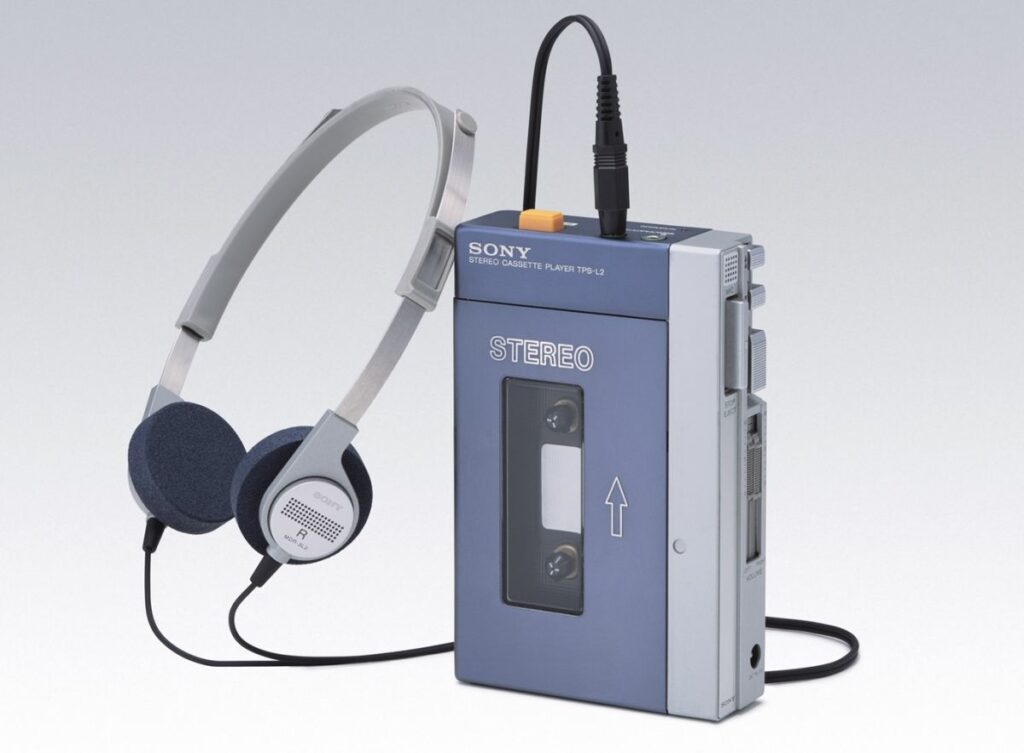
К 90-м годам прошлого века произошло создание прототипов беспроводных моделей. А в 1998 для подключения стала использоваться технология Bluetooth.
Вывод
Со времени создания первых прототипов наушников прошло более 100 лет. С тех пор эти аксессуары сильно эволюционировали. Кроме накладных моделей появились вкладыши с активным шумоподавлением, затычки (капельки) и даже устройства костного типа. С фото и дополнительной информацией ознакомиться можно в википедии.
Запутанная история
По-другому историю создания наушников и не назовешь. Впервые наушники были запатентованы ещё в 1891 году под названием «би-телефон». На самом деле они представляли собой два скрепленных дугой приемника.
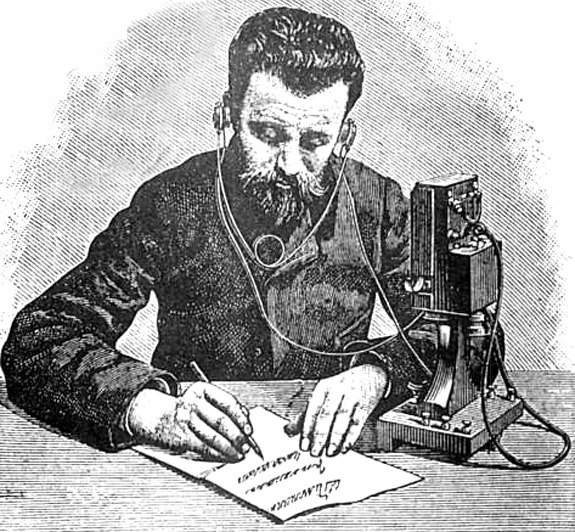
Эрнест Меркадье со своими наушниками
Французский изобретатель Эрнест Меркадье создал первые наушники таким образом, что дуга была не над головой, как привычно нам, а скрепляла приемники снизу. Его изобретением незамедлительно воспользовались коммерсанты, создав в Англии специальный сервис по прослушиванию оперы, развлекательных шоу и даже воскресных проповедей.
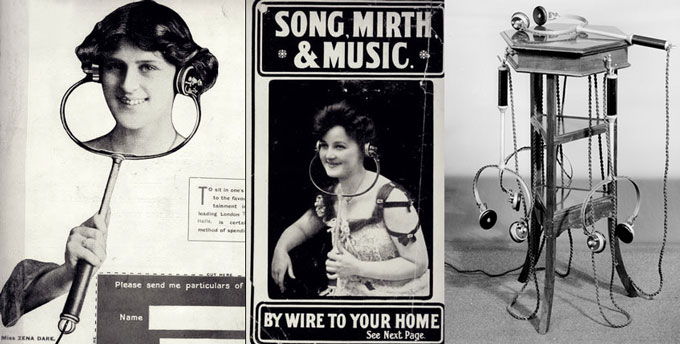
Наушники продавались с громоздкой ручкой
Современный экземпляр
В том виде, к которому мы вполне привыкли, наушники были изобретены Натаниэлем Болдуином. На самом деле в 1910 году Болдуин лишь усовершенствовал имеющиеся модели наушников, однако надолго закрепил за собой имя «изобретателя» наушников. Наушники Болдуина регулировались по высоте и удобно держались на голове.

Наушники Натаниэля Болдуина
Натаниэль сконструировал свои первые наушники на своей кухне. Первый тест показал, что его наушники в два раза чувствительнее всех существующих аналогов. Буквально сразу же Болдуин сообразил, что его изобретением должны заинтересоваться военные. Так наушники оказались в руках американской армии. Через несколько лет именно предложенная Болдуином модель будет главным средством связи для всех операторов военно-морского флота.
На полках магазинов
Свою популярность в народе наушники приобрели в 1920-х годах, когда они стали использоваться для прослушивания радиоприемников. С некоторыми радиоприемниками наушники выдавались в придачу при покупке. Ещё одним популярным товаром стал набор «сделай сам», в котором находились комплектующие и инструкция по сборке наушников. Брендовый приемник с наушниками можно было получить даже в качестве поощрения за покупку овсяных хлопьев. Для этого достаточно было собрать определенное число упаковок и обменять их на приз.

Музыкальные наушники
Главной проблемой наушников первой полвины XX века было то, что слушать музыка в них было практически невозможно. Наушники тех лет отлично справлялись с голосом, но вот прослушивание музыкальных композиций превращалось в настоящую пытку. Изменить ситуация попытался молодой шведский изобретатель Ойген Байер, который в ещё совсем юном возрасте основал собственную фирму по производству наушников и микрофонов. В 1937 году Байер смог добиться того, чтобы его наушники качественно воспроизводили музыку.
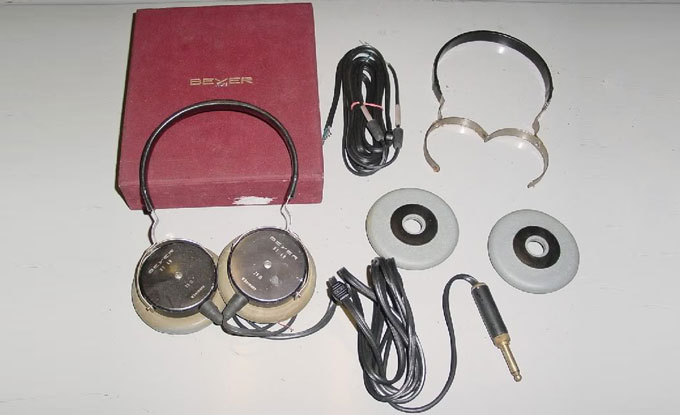
Первая модель наушников фирмы Ойгена Байера
Первая модель наушников «Beyerdynamic DT 48» долгое время оставалась в тени. Только спустя двадцать лет после выпуска первой пары, в конце пятидесятых годов, в продаже появилась модифицированная стереоверсия этой модели, а любители музыки наконец-то обратили на нее внимание. Интересно, что DT 48 продается и поныне. В ней сохранен не только дизайн оригинальных наушников, но и технические характеристики.
Sennheiser и первые открытые наушники
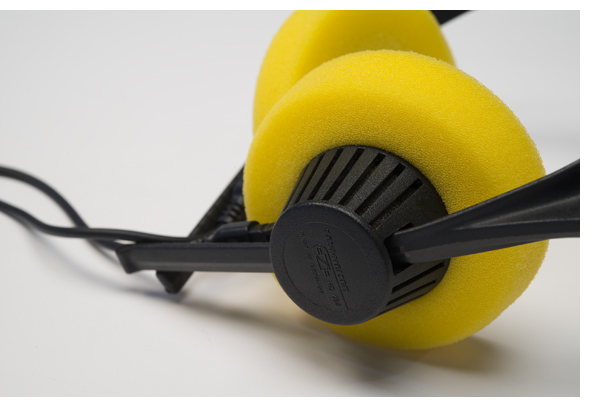
Sennheiser HD 414 — первая модель открытых наушников
Вплоть до 1968 года абсолютно все наушники были закрытыми. То есть обратная от уха сторона драйвера всегда была закрыта. Первый же эксперимент по созданию открытых наушников принес компании «Sennheiser», запатентовавшей эту технологию, огромные деньги. Впрочем, до сих пор каждый производитель открытых наушников платит часть денег фирме «Sennheiser».



